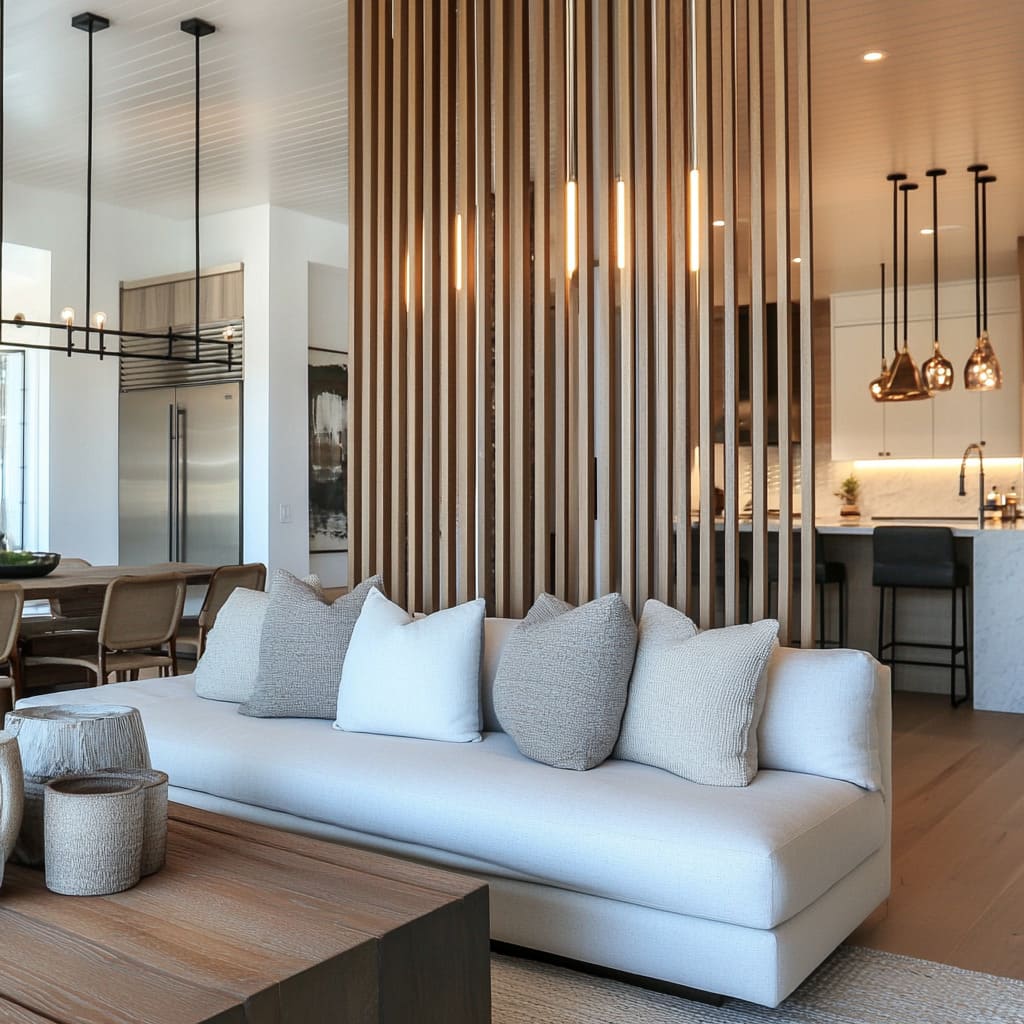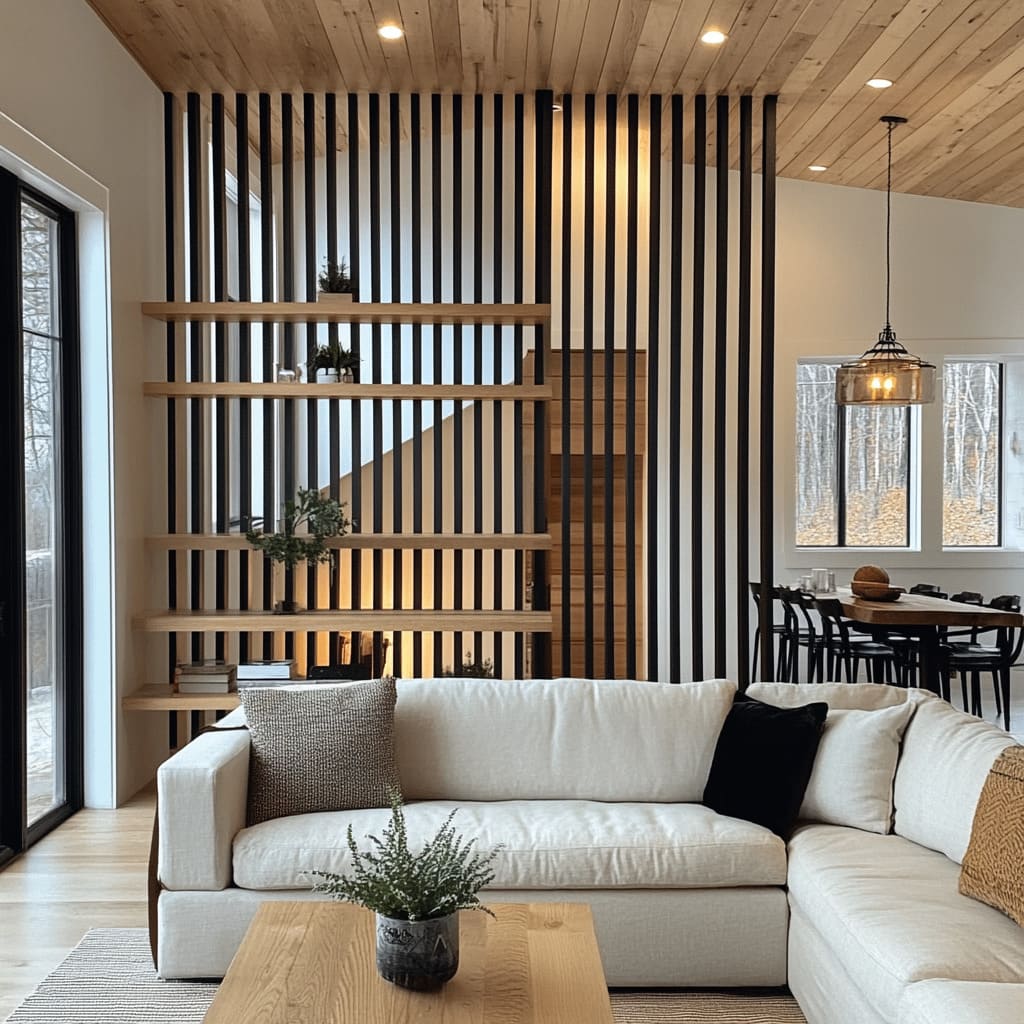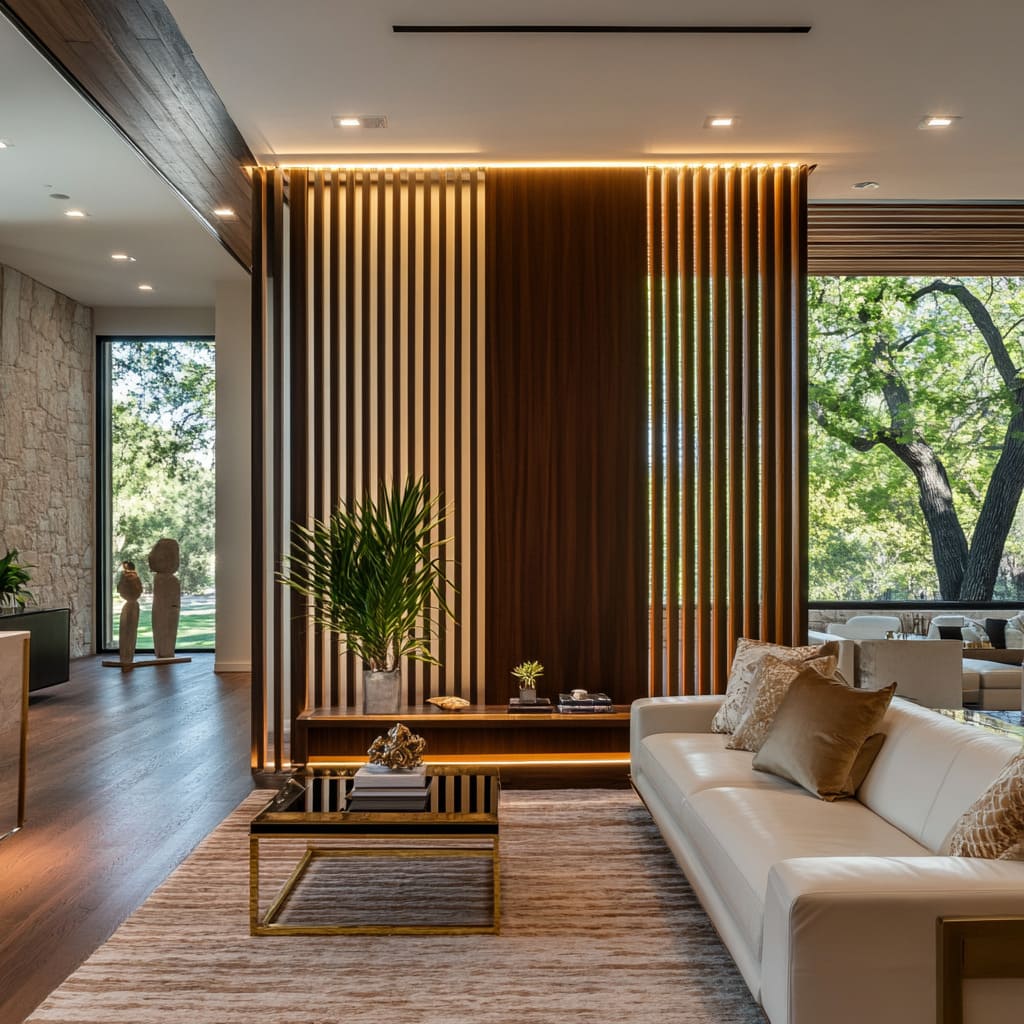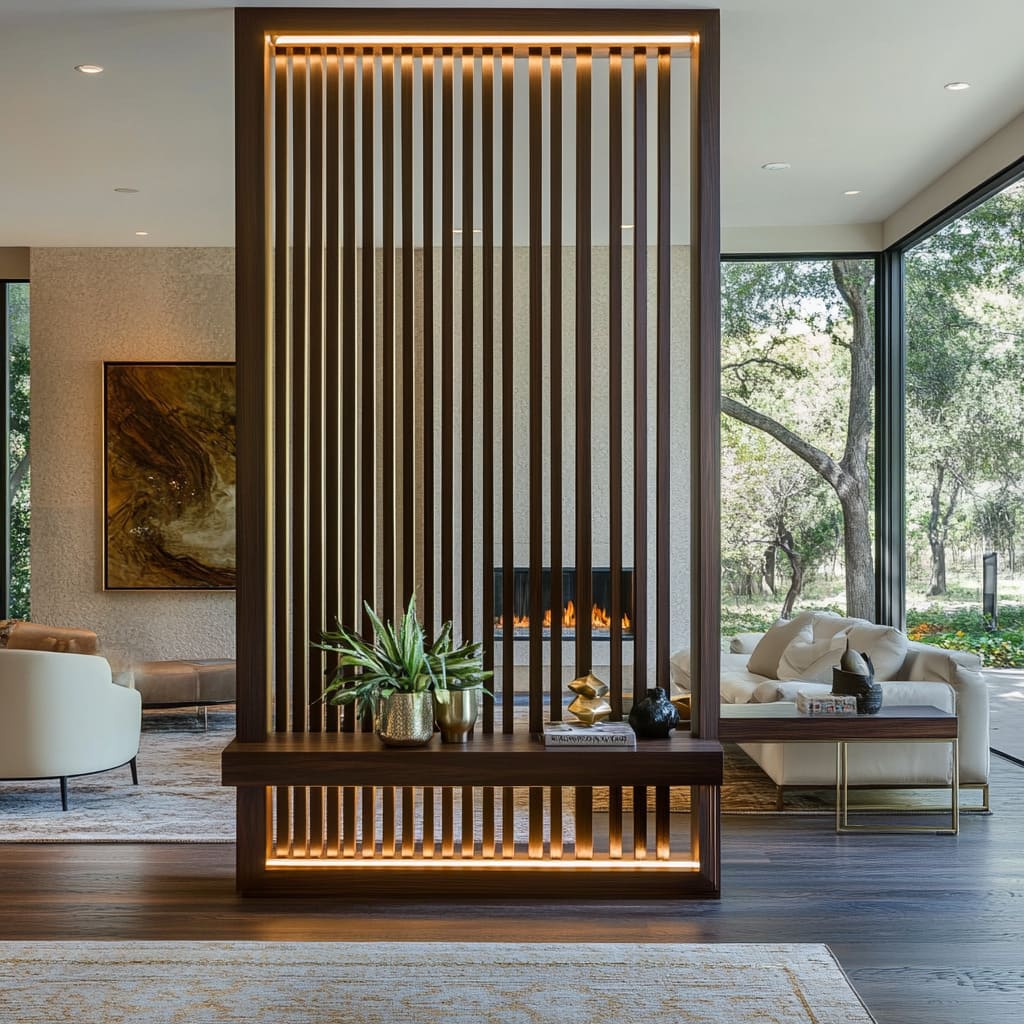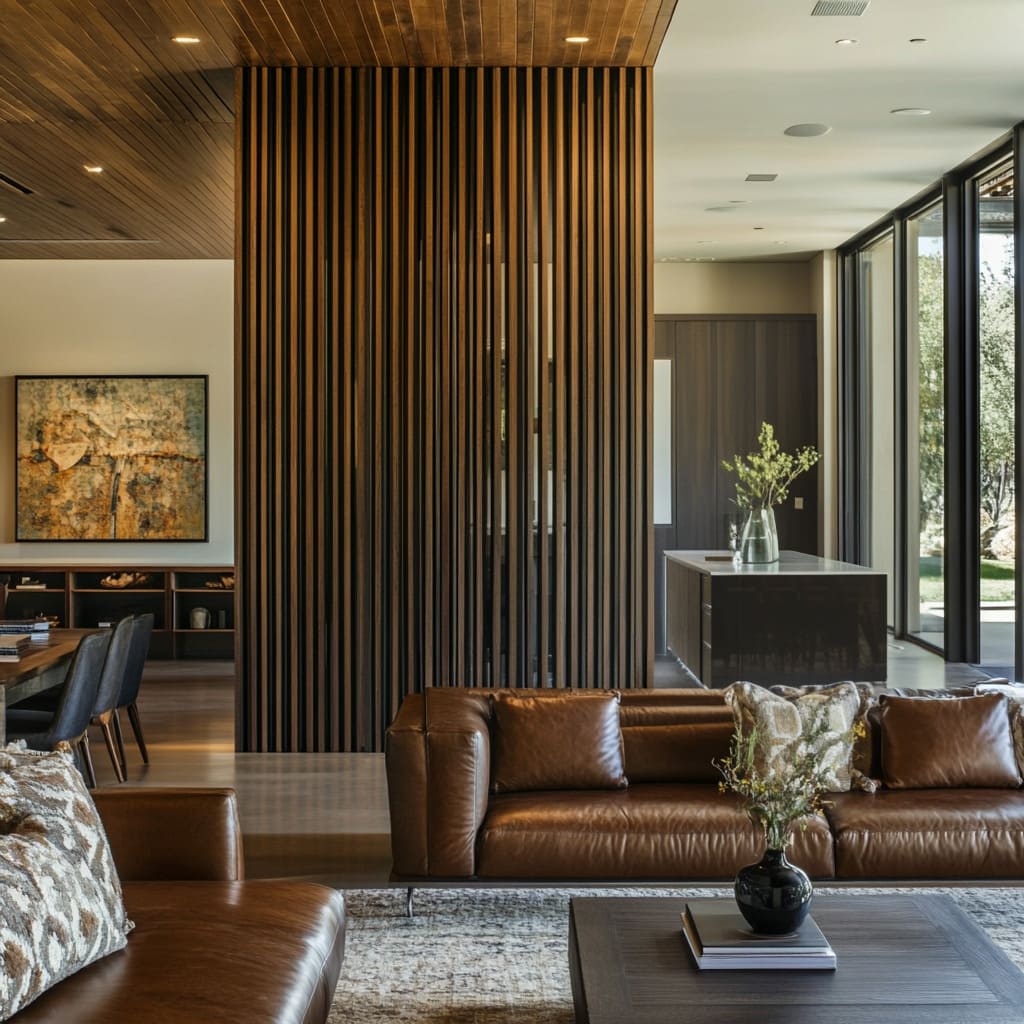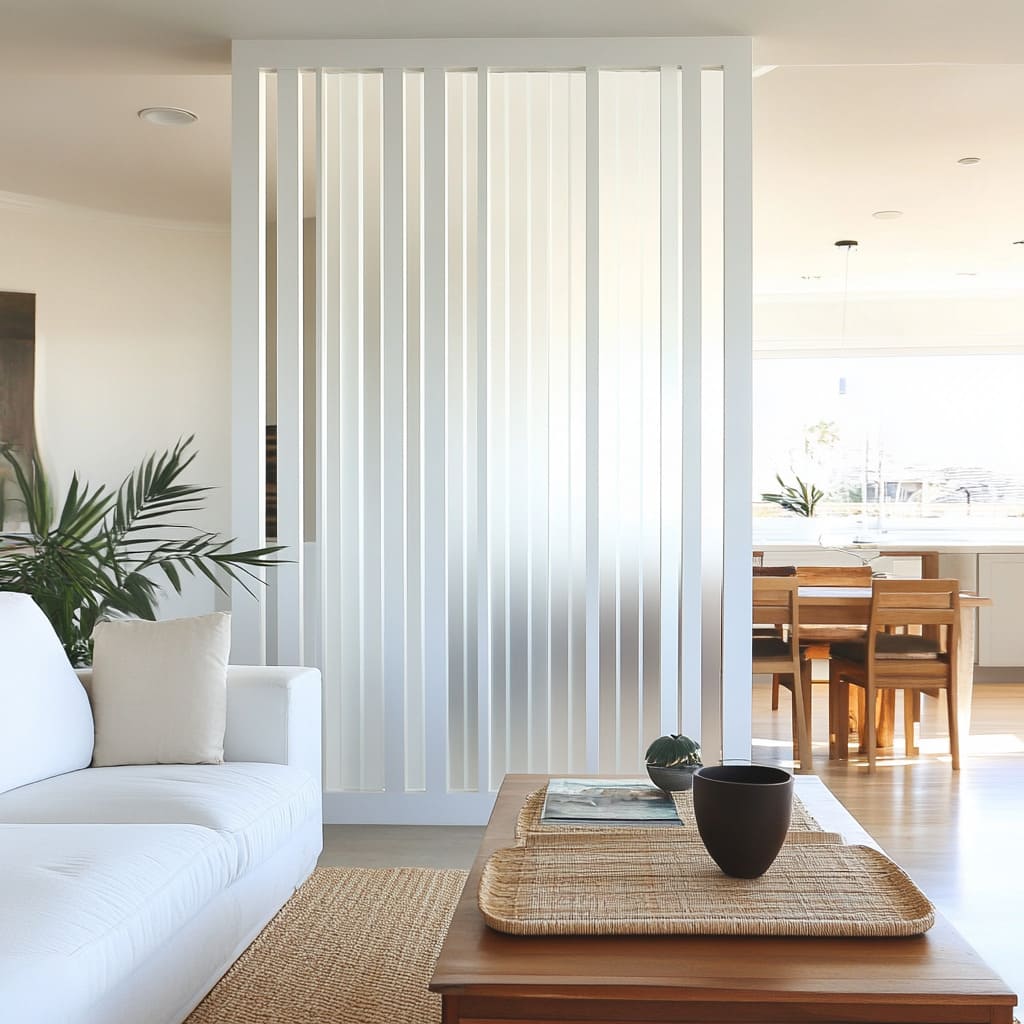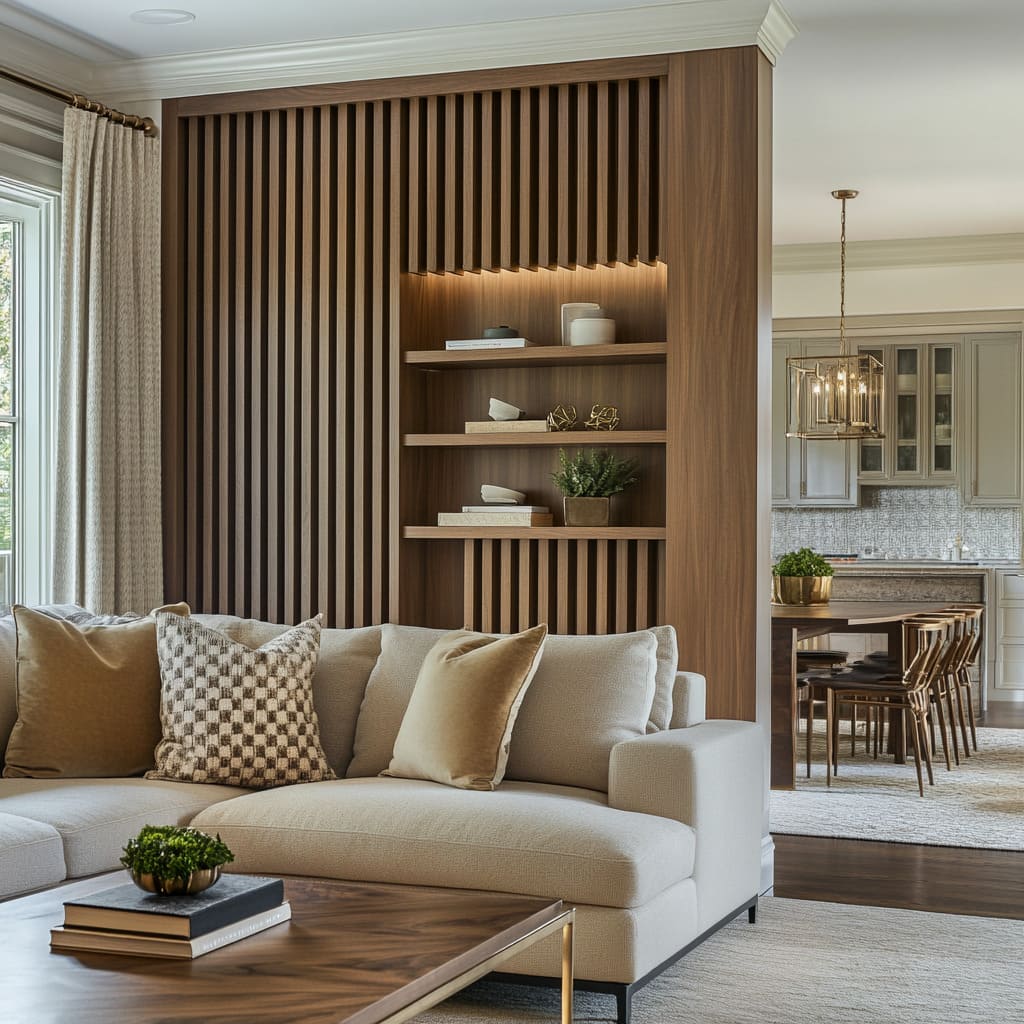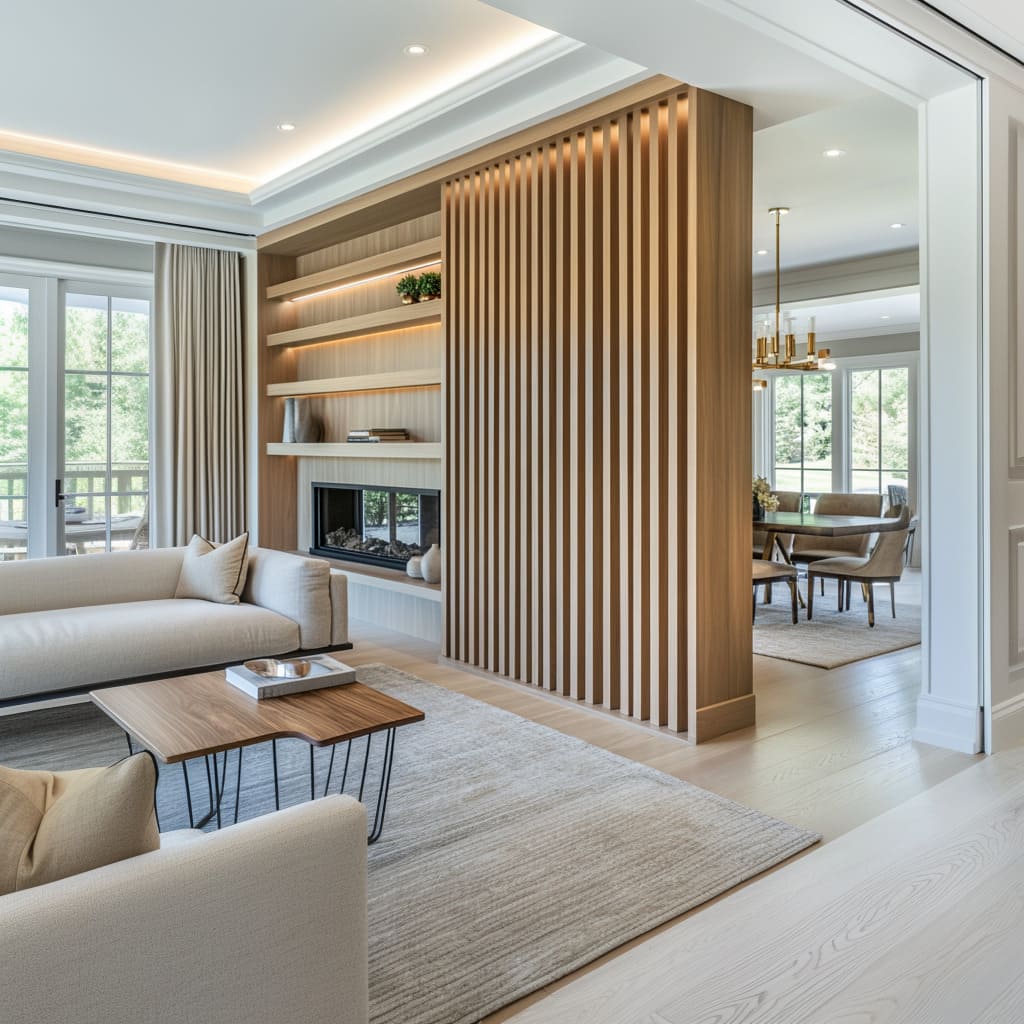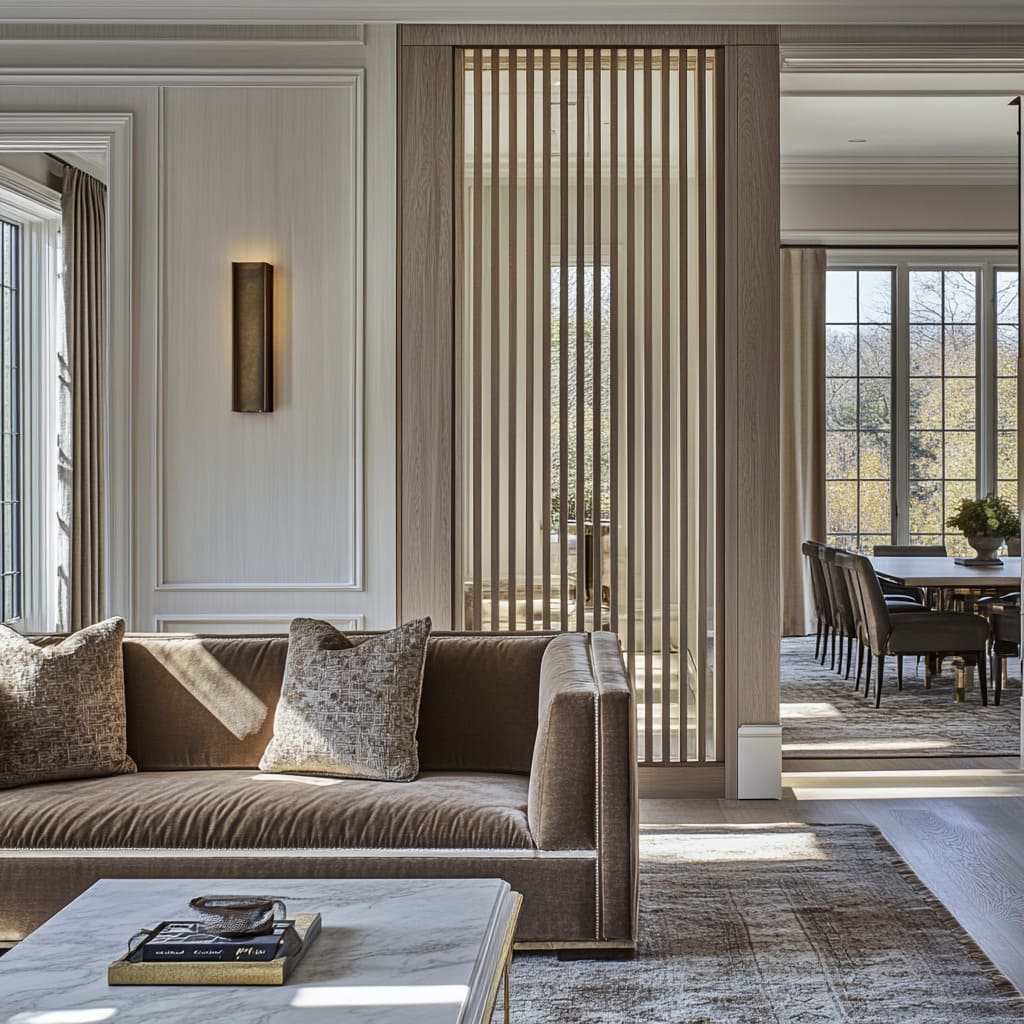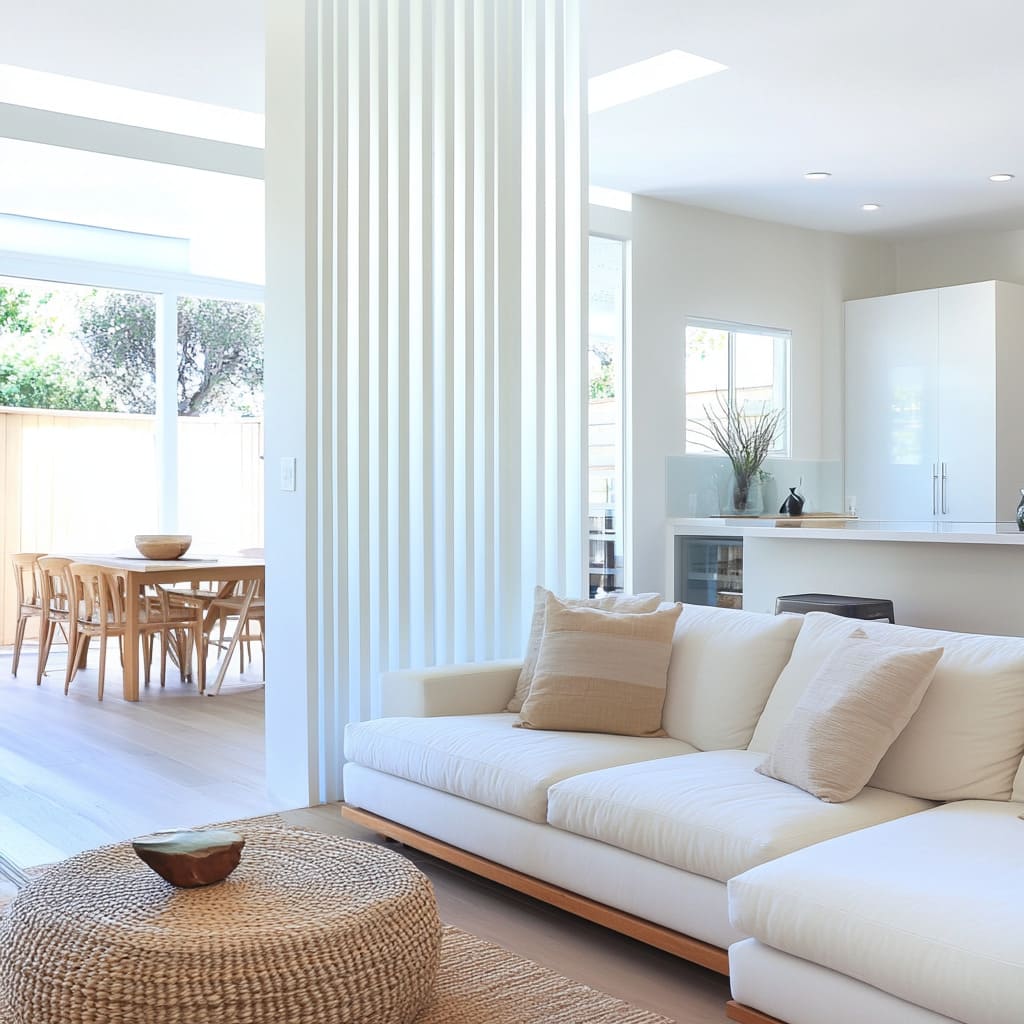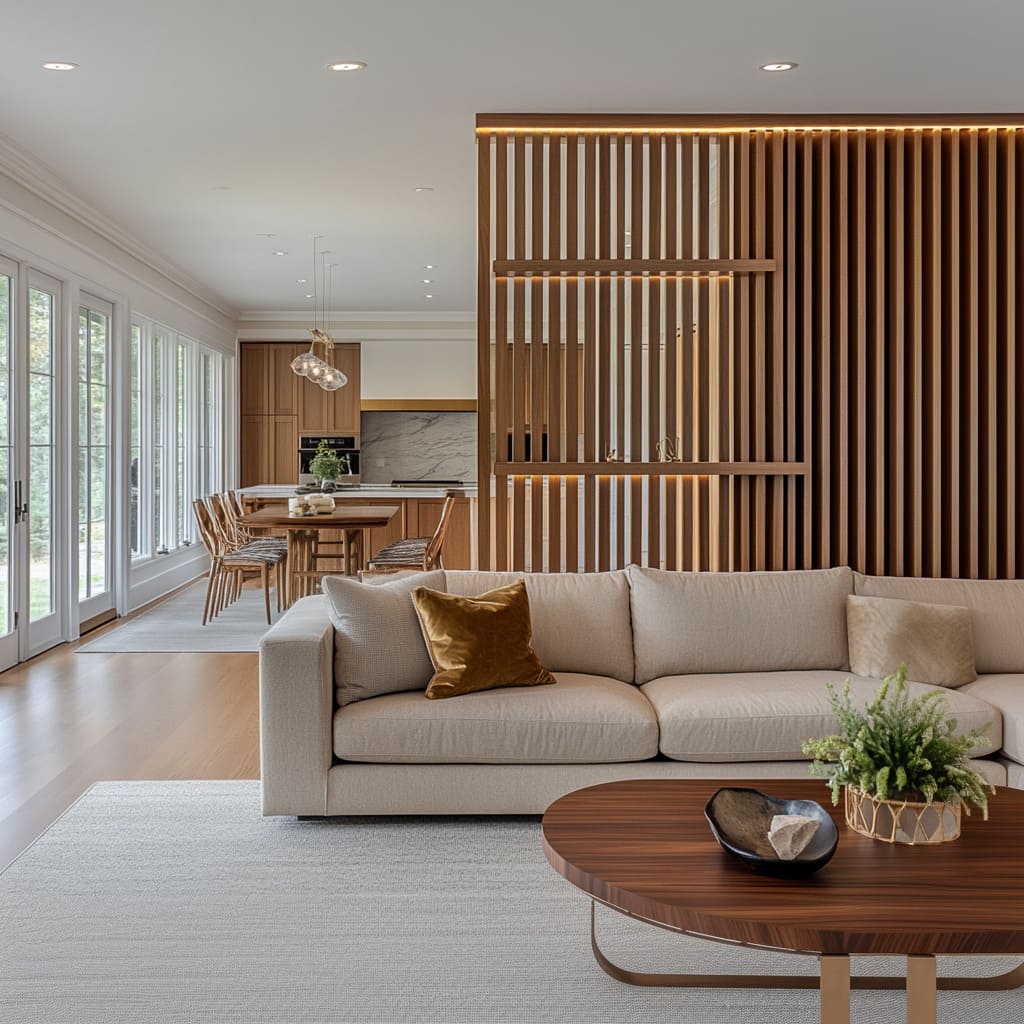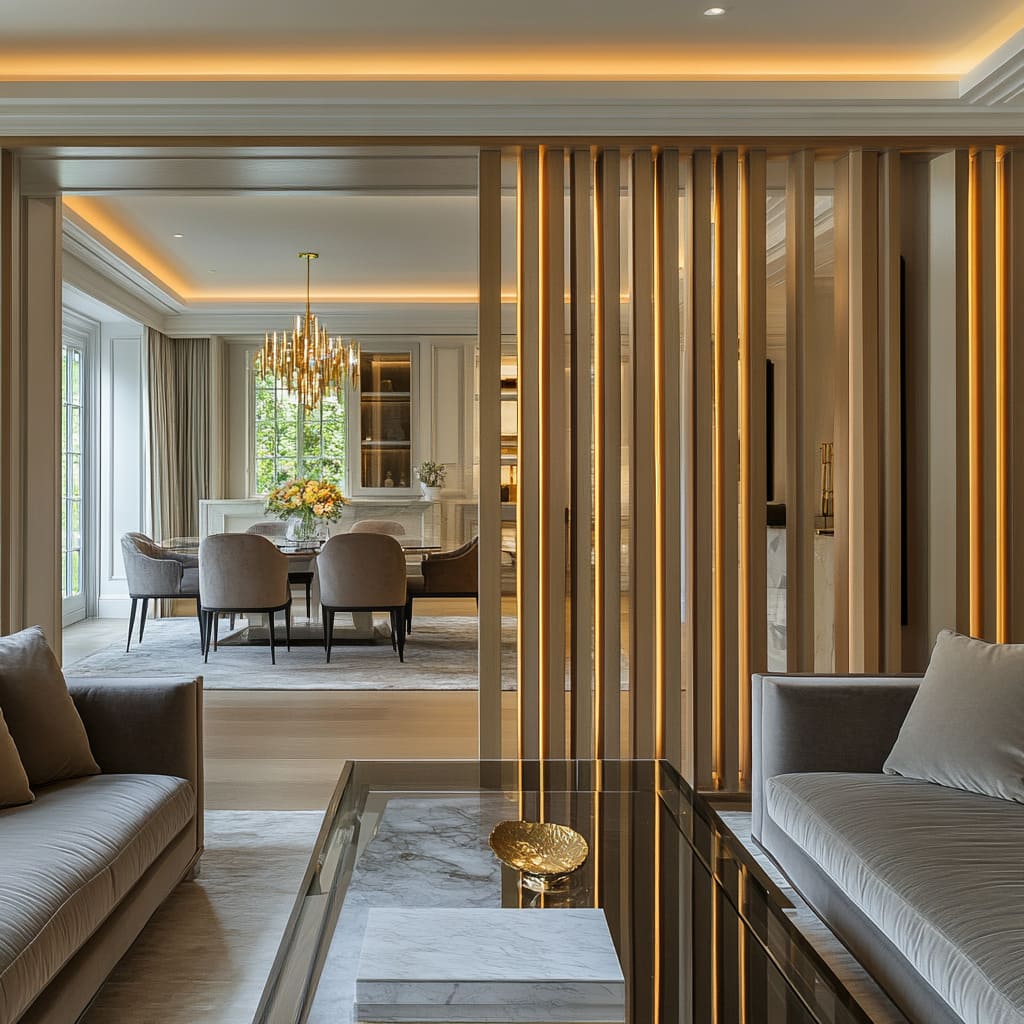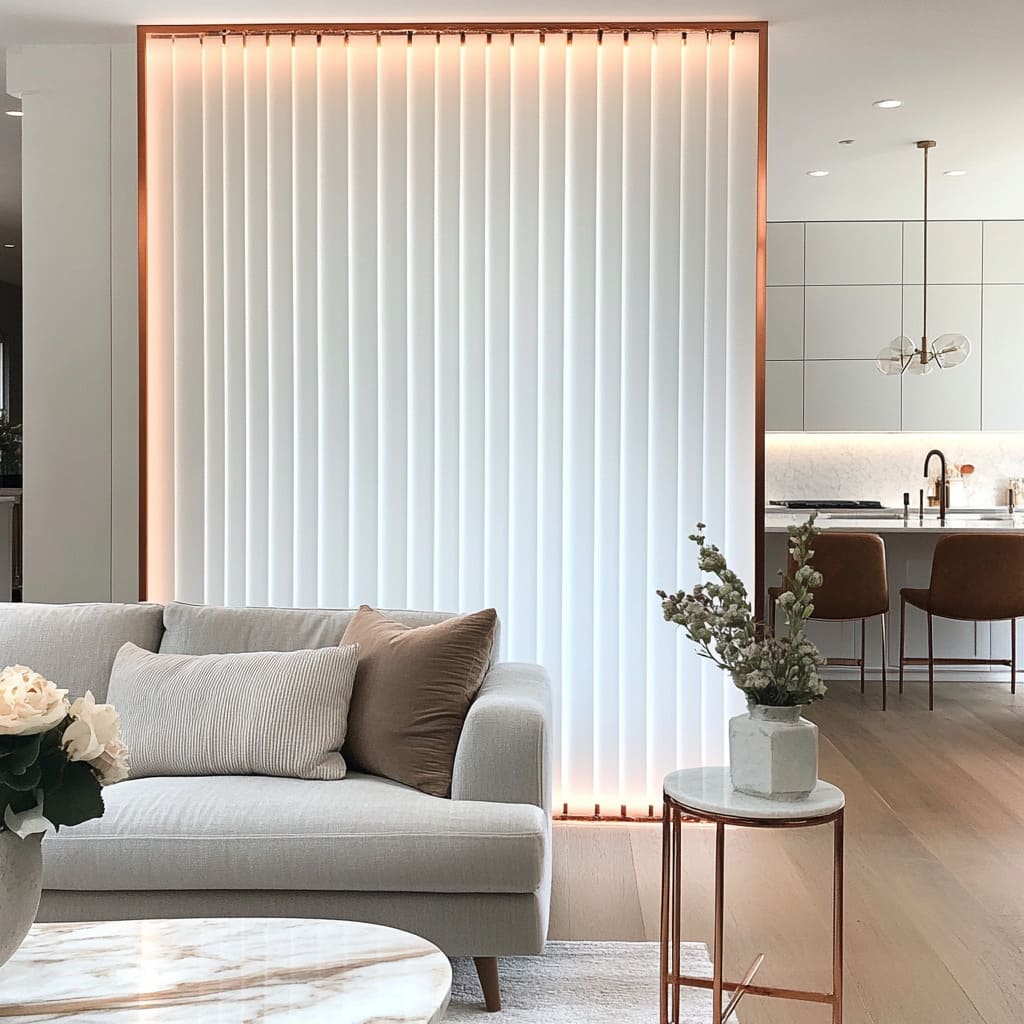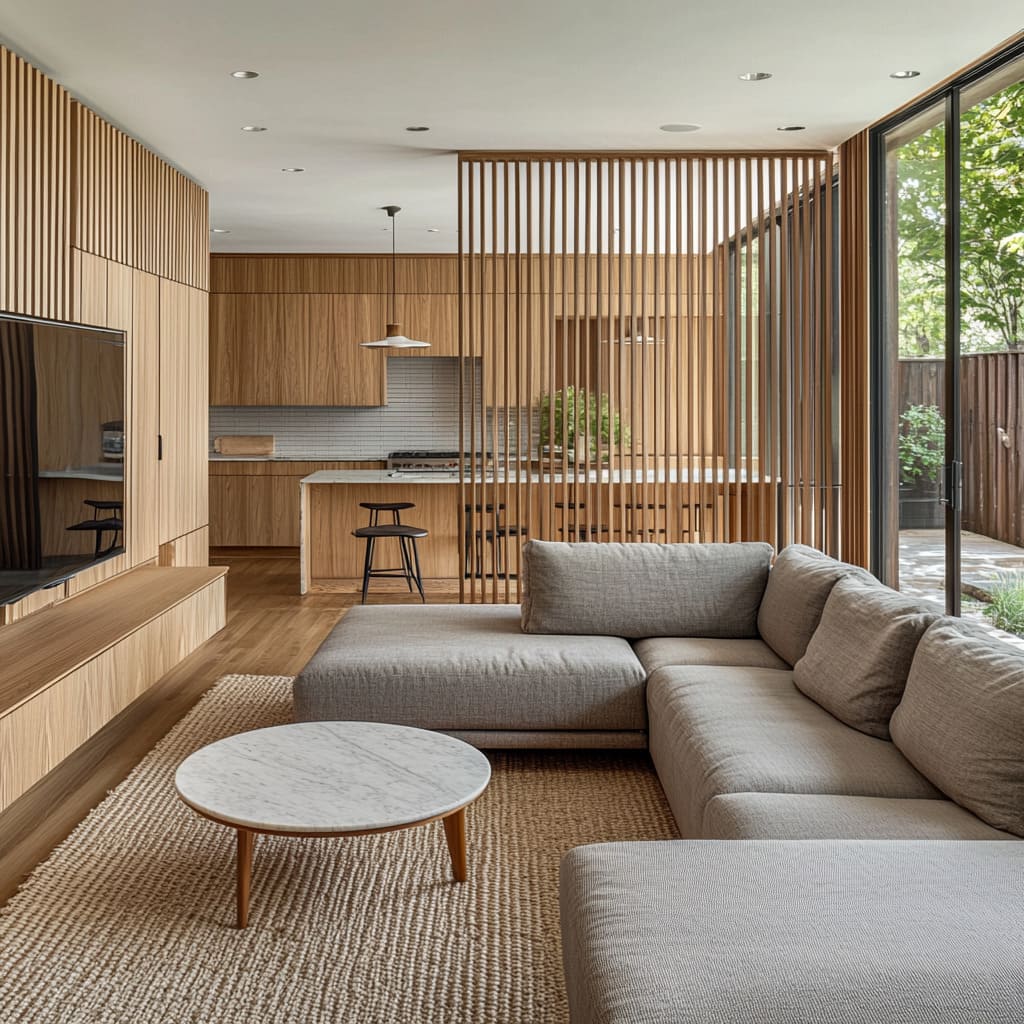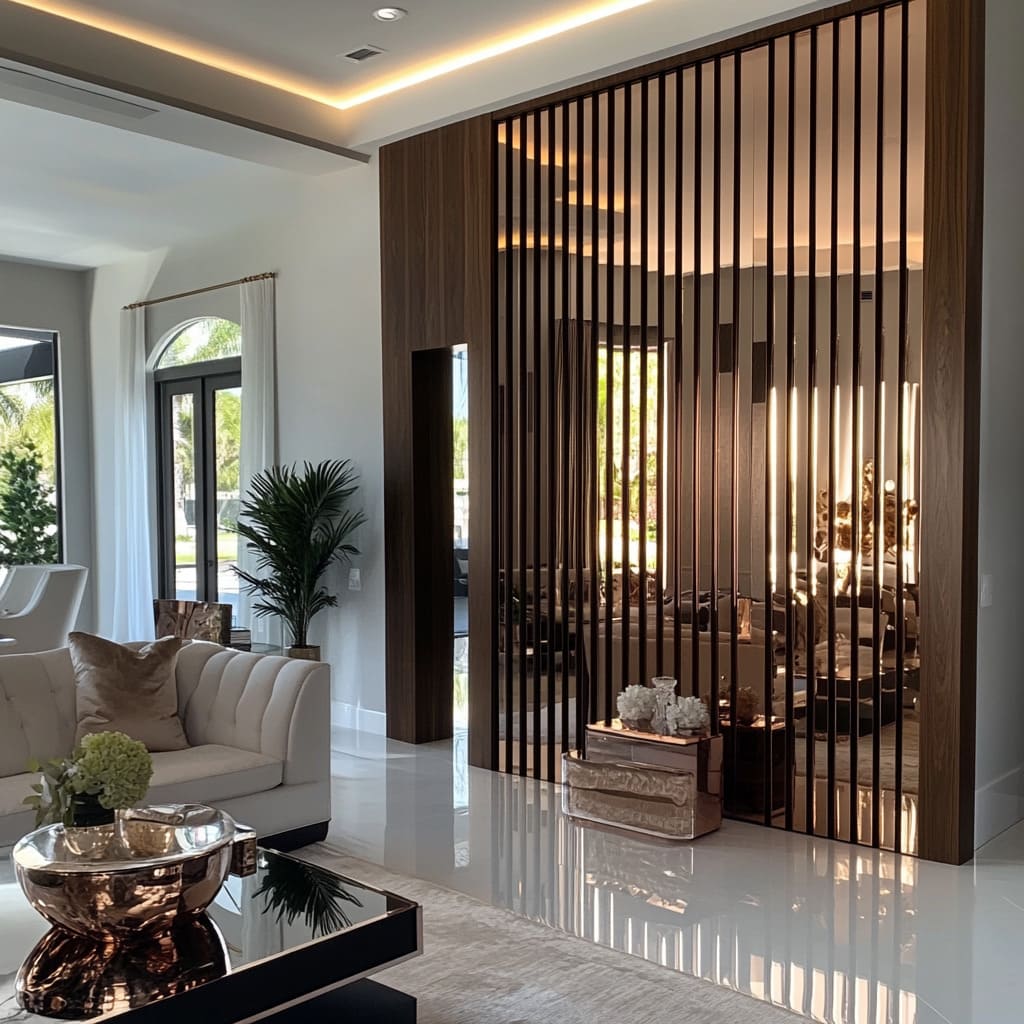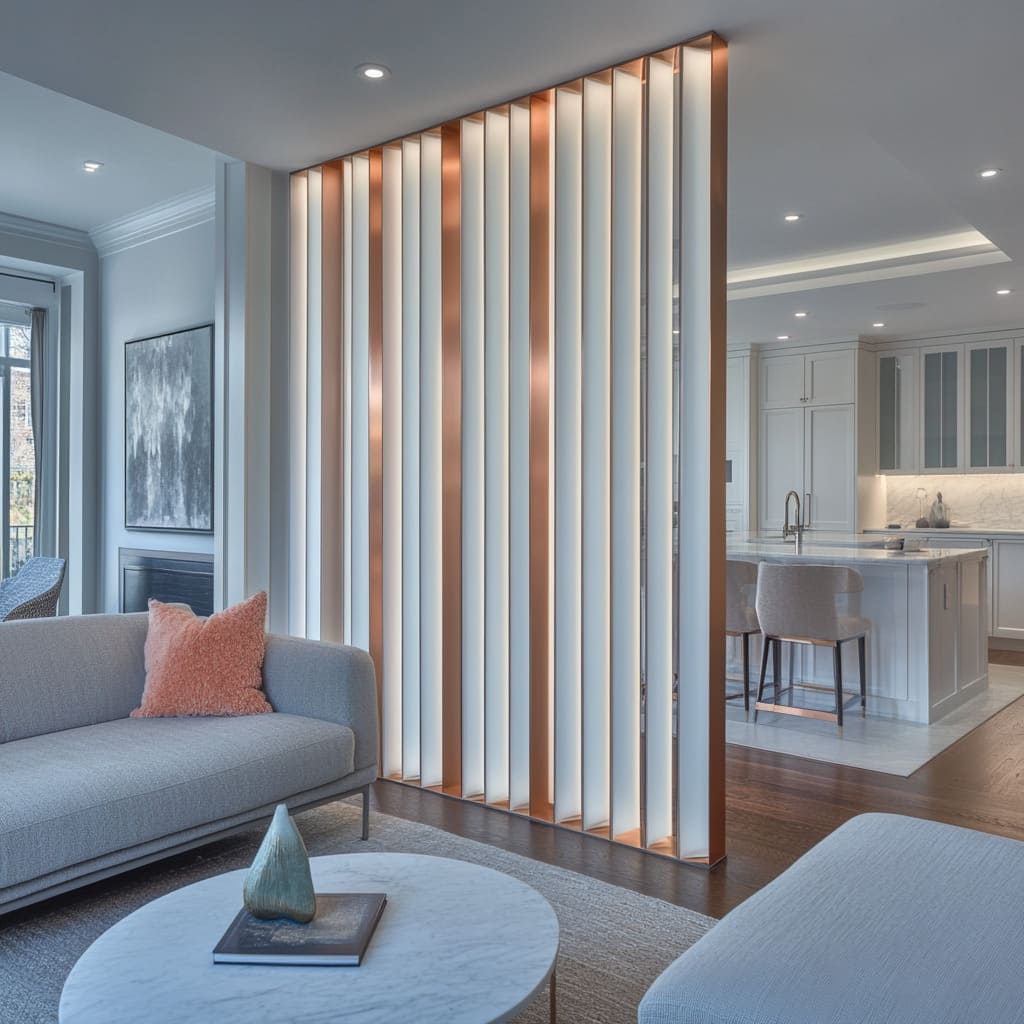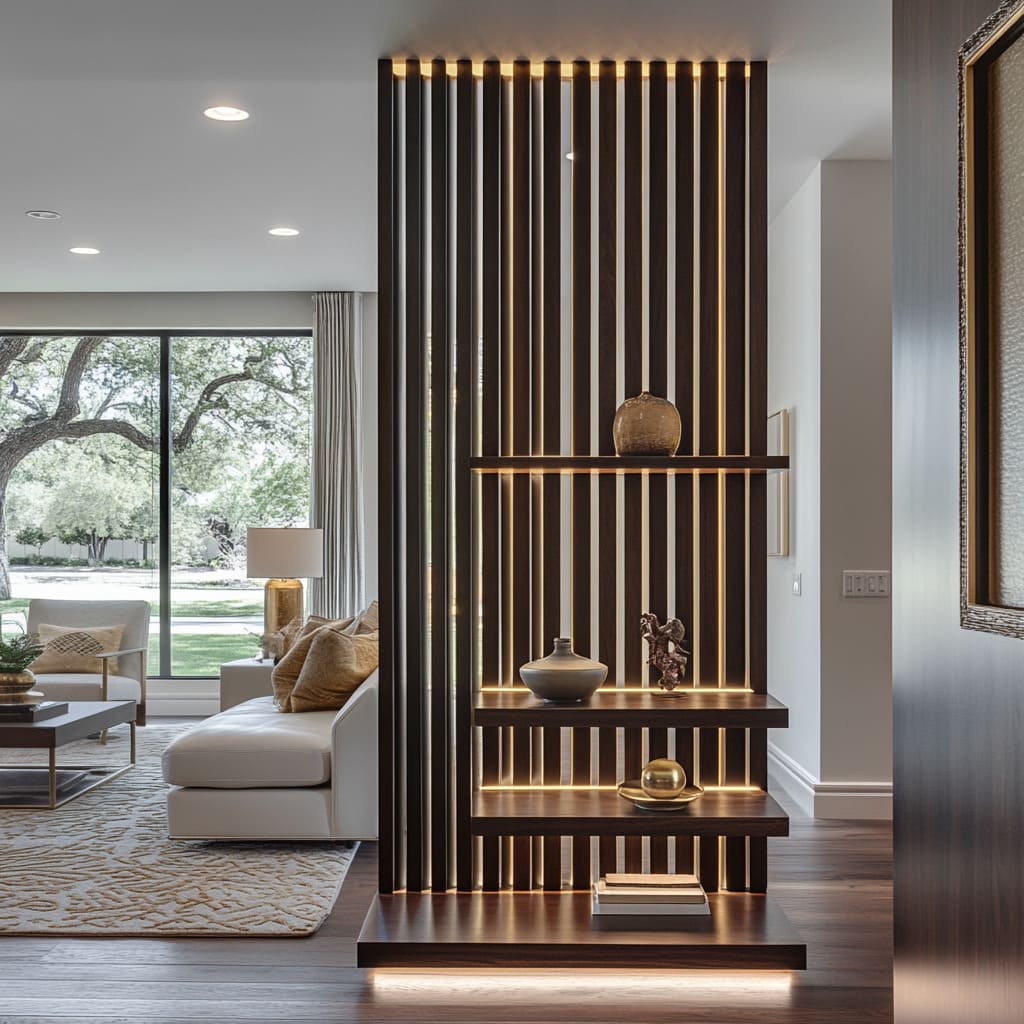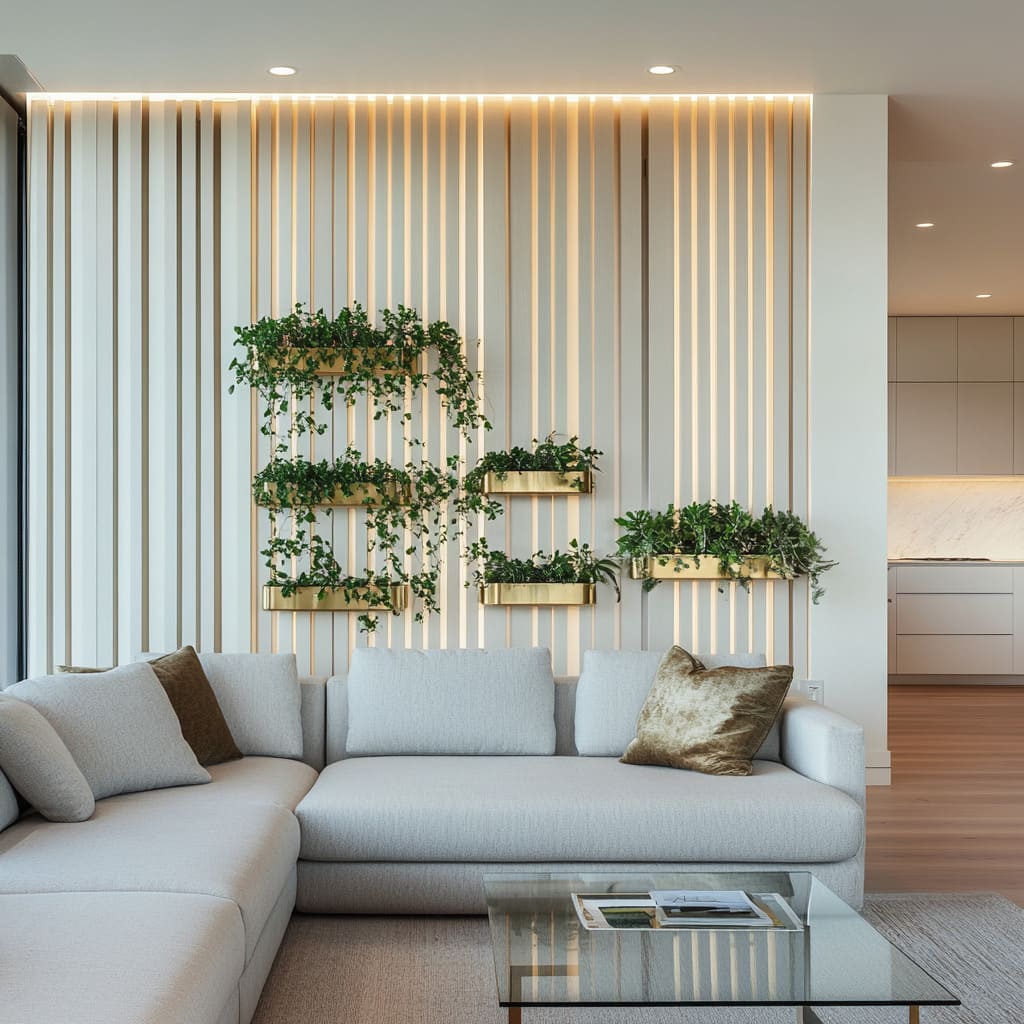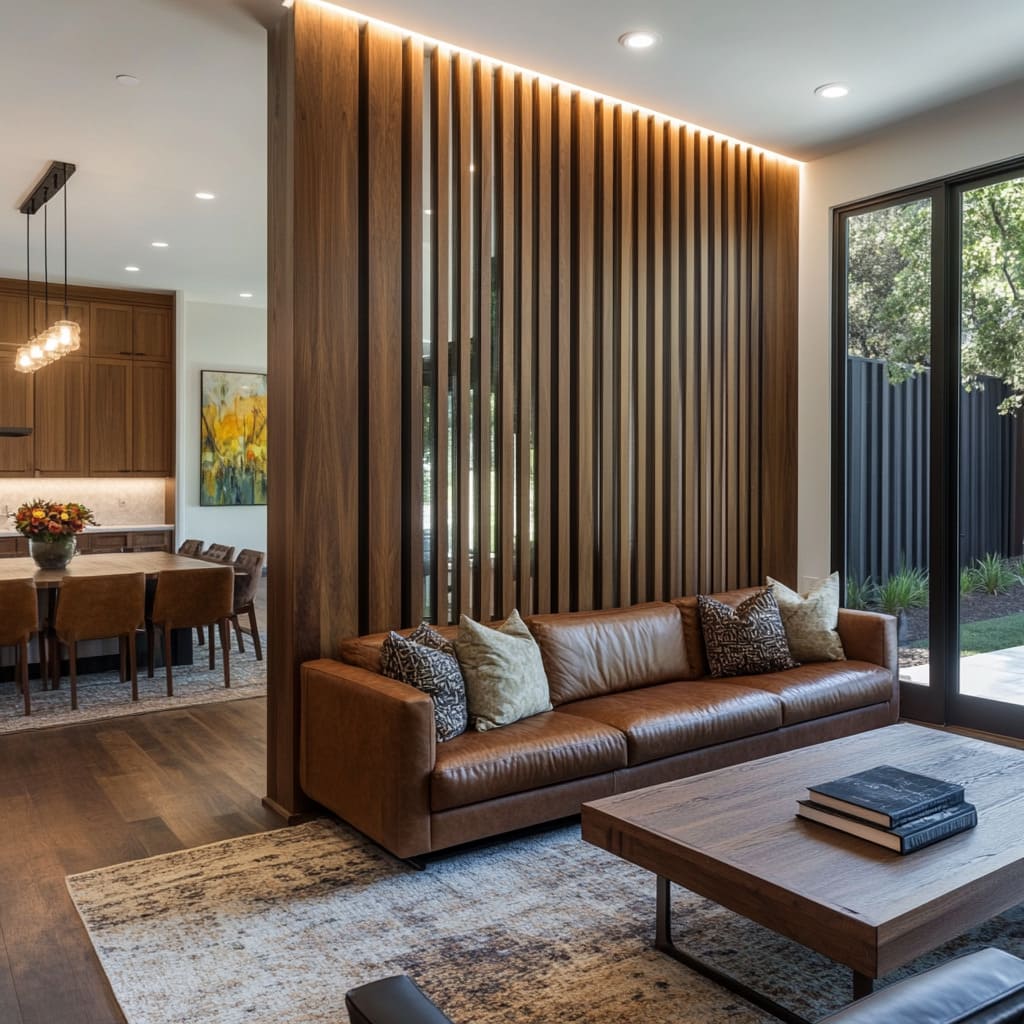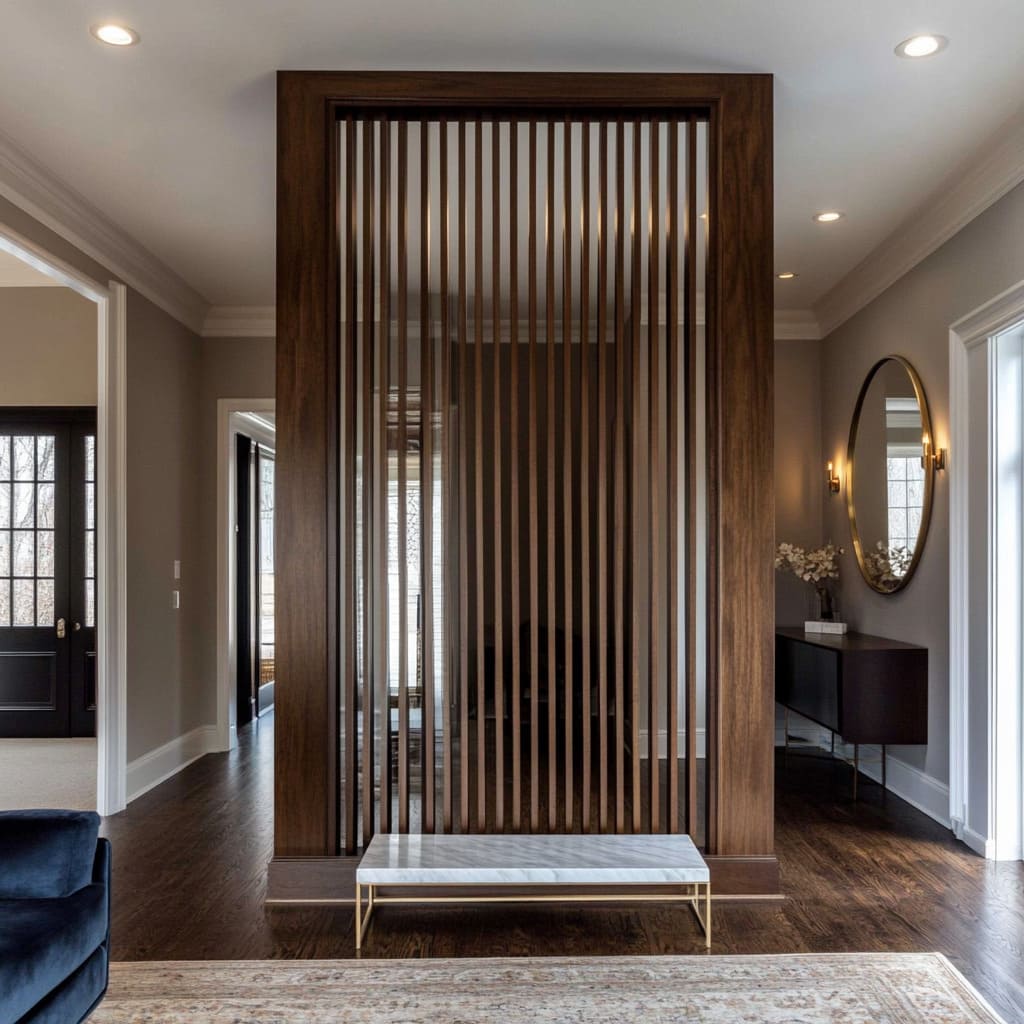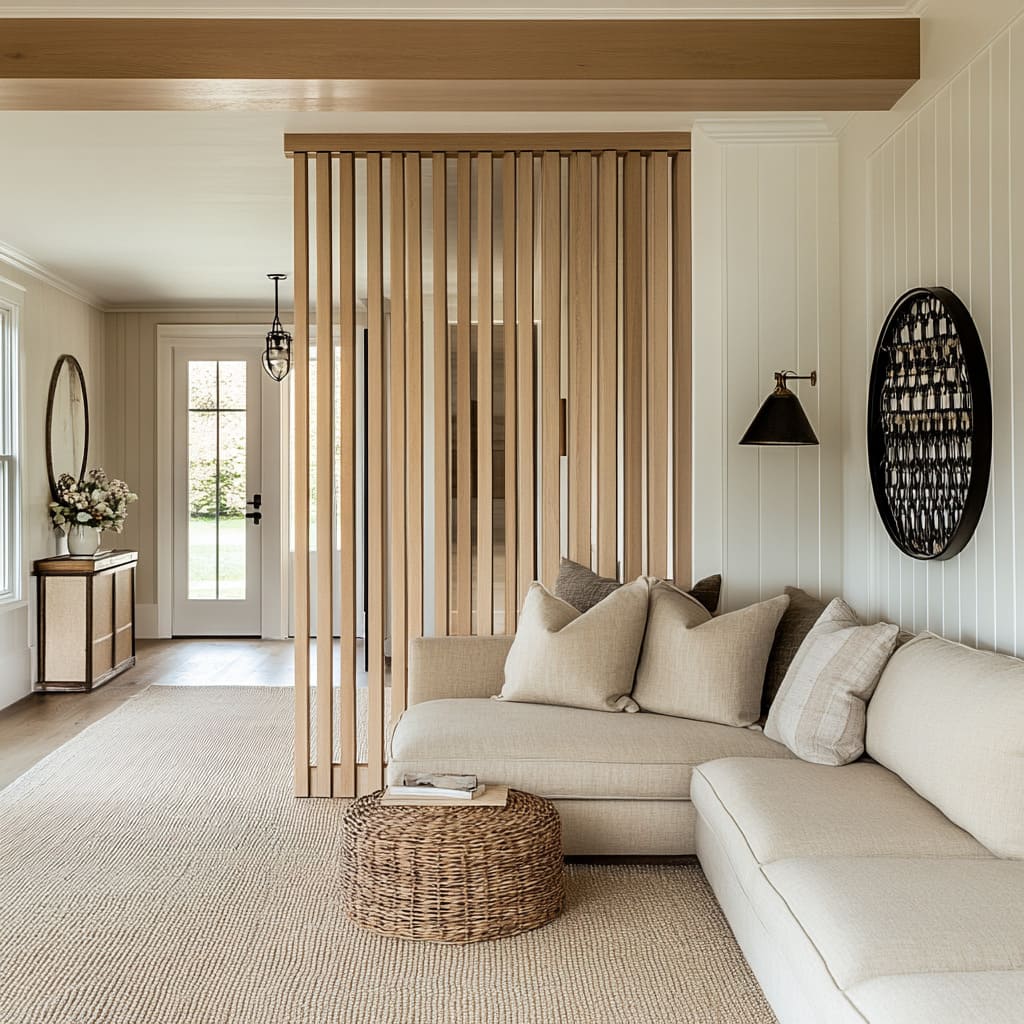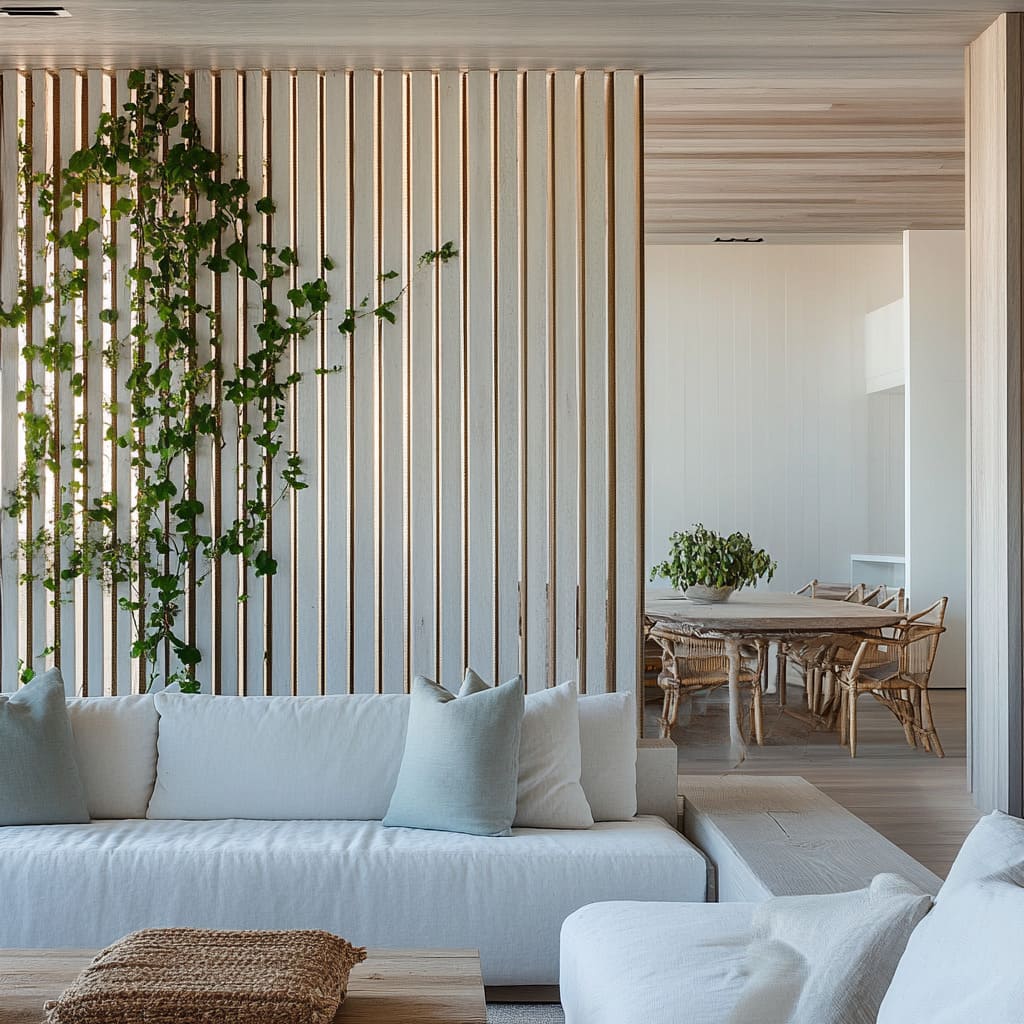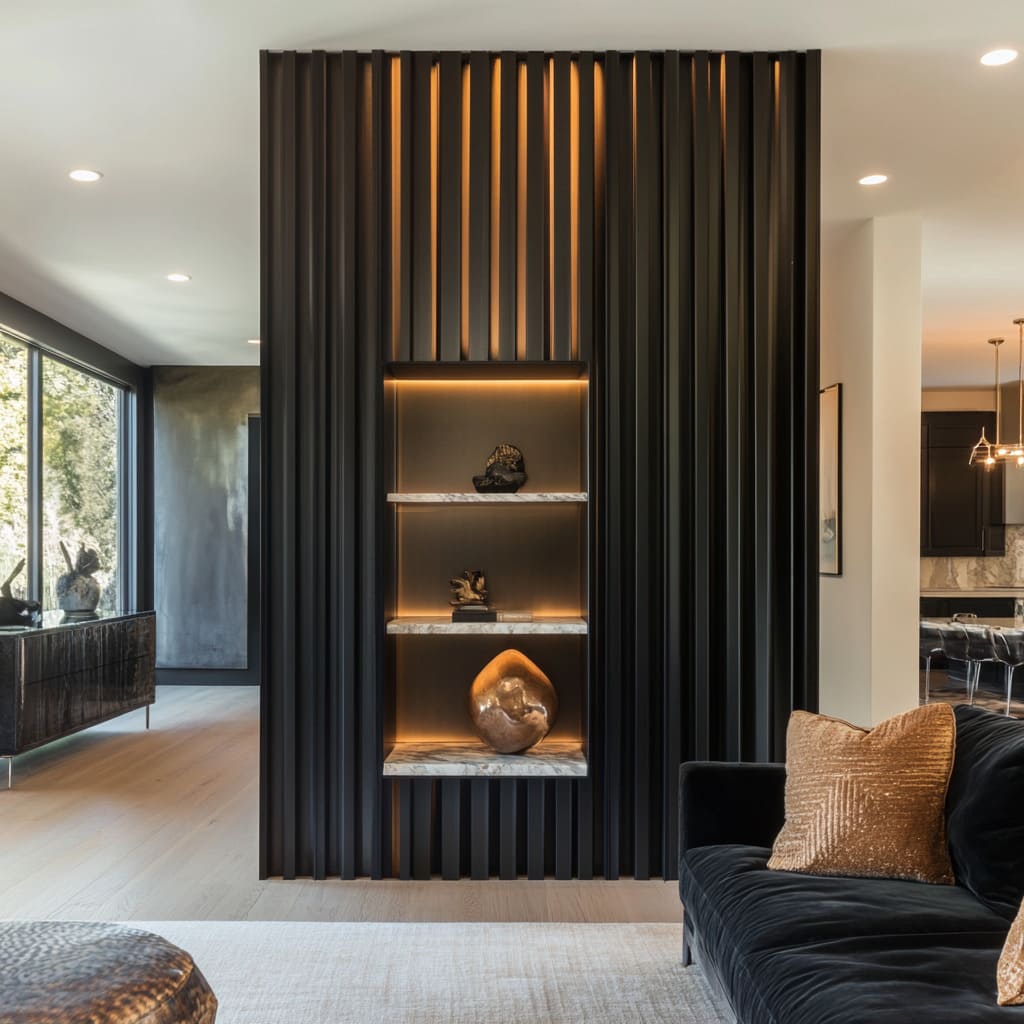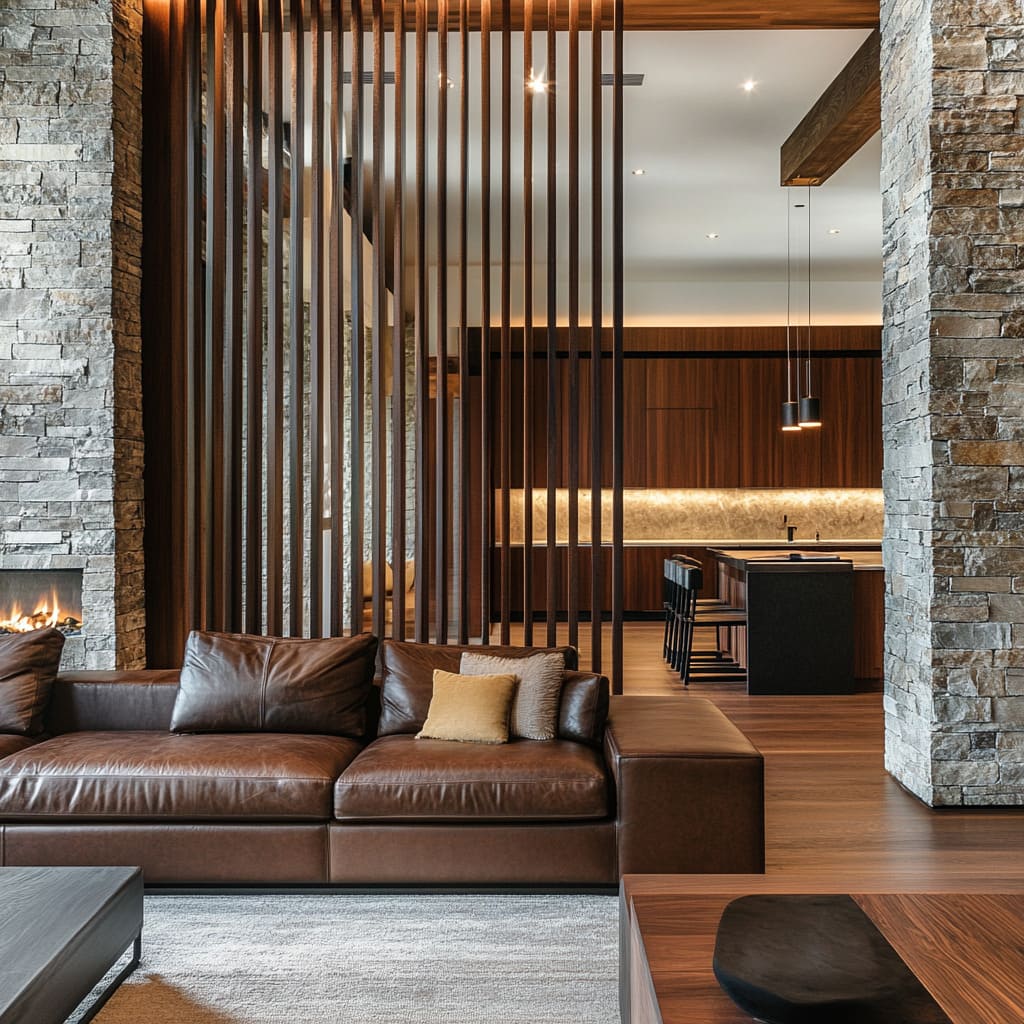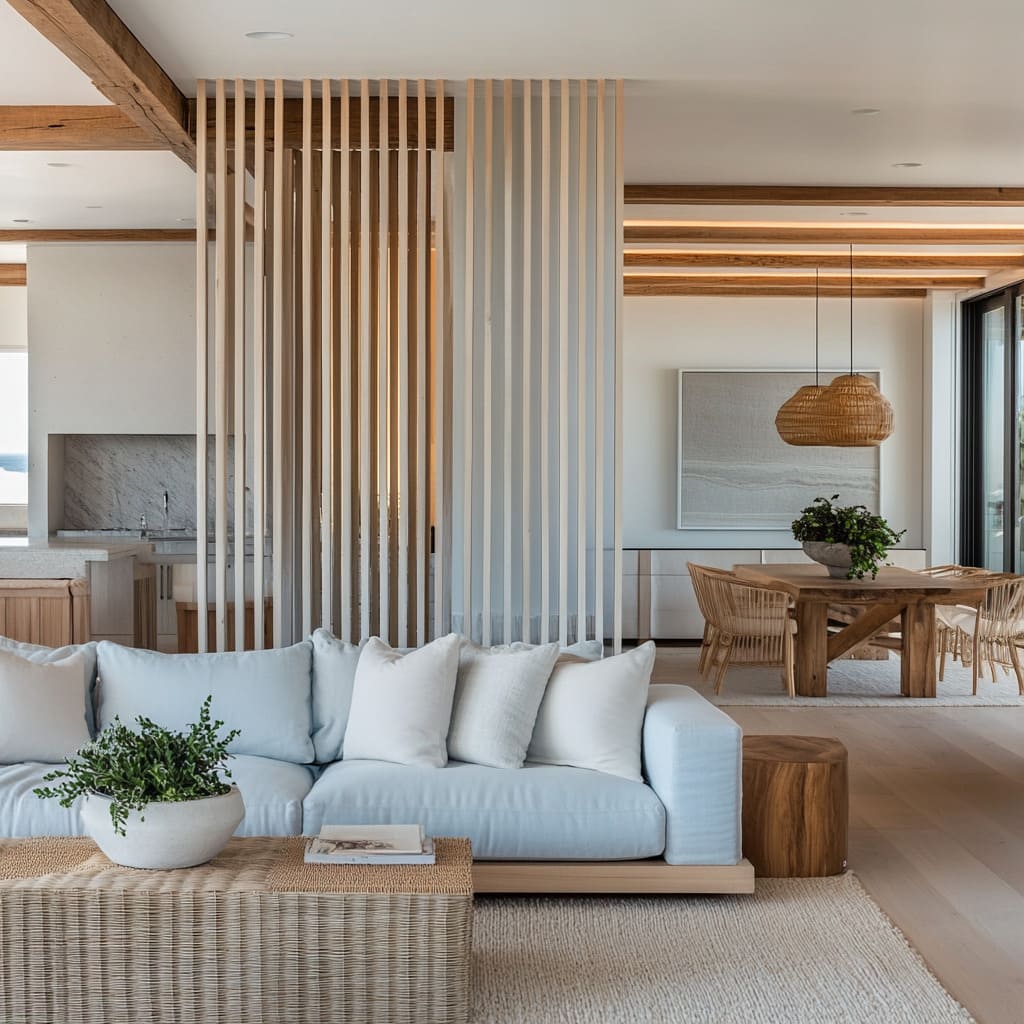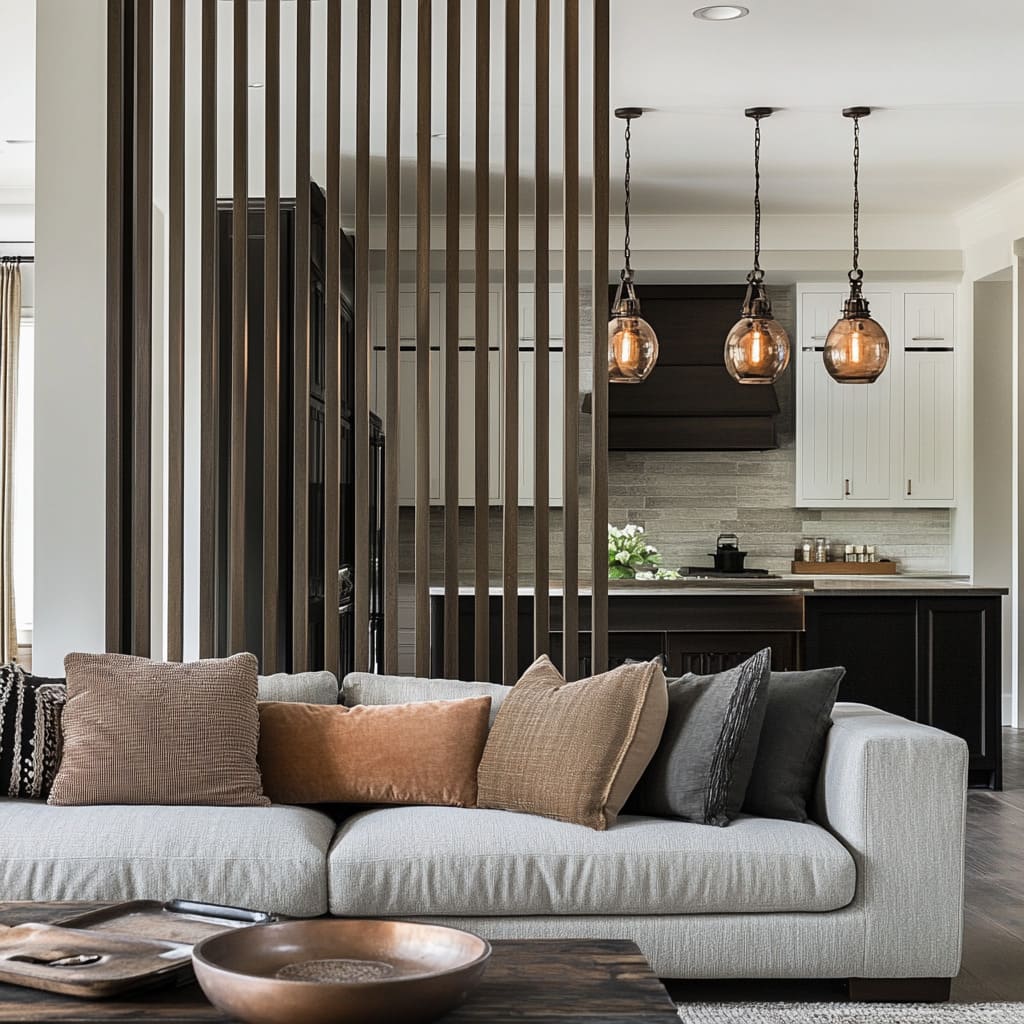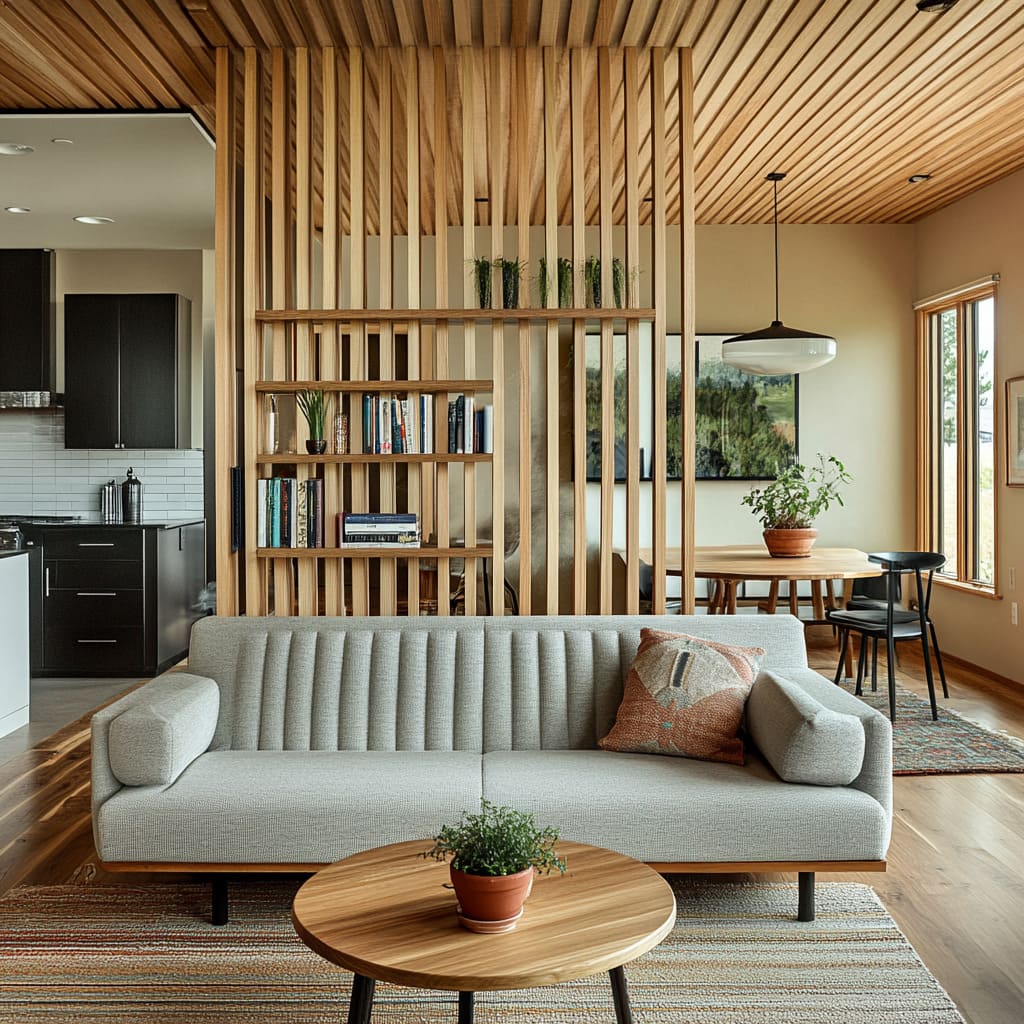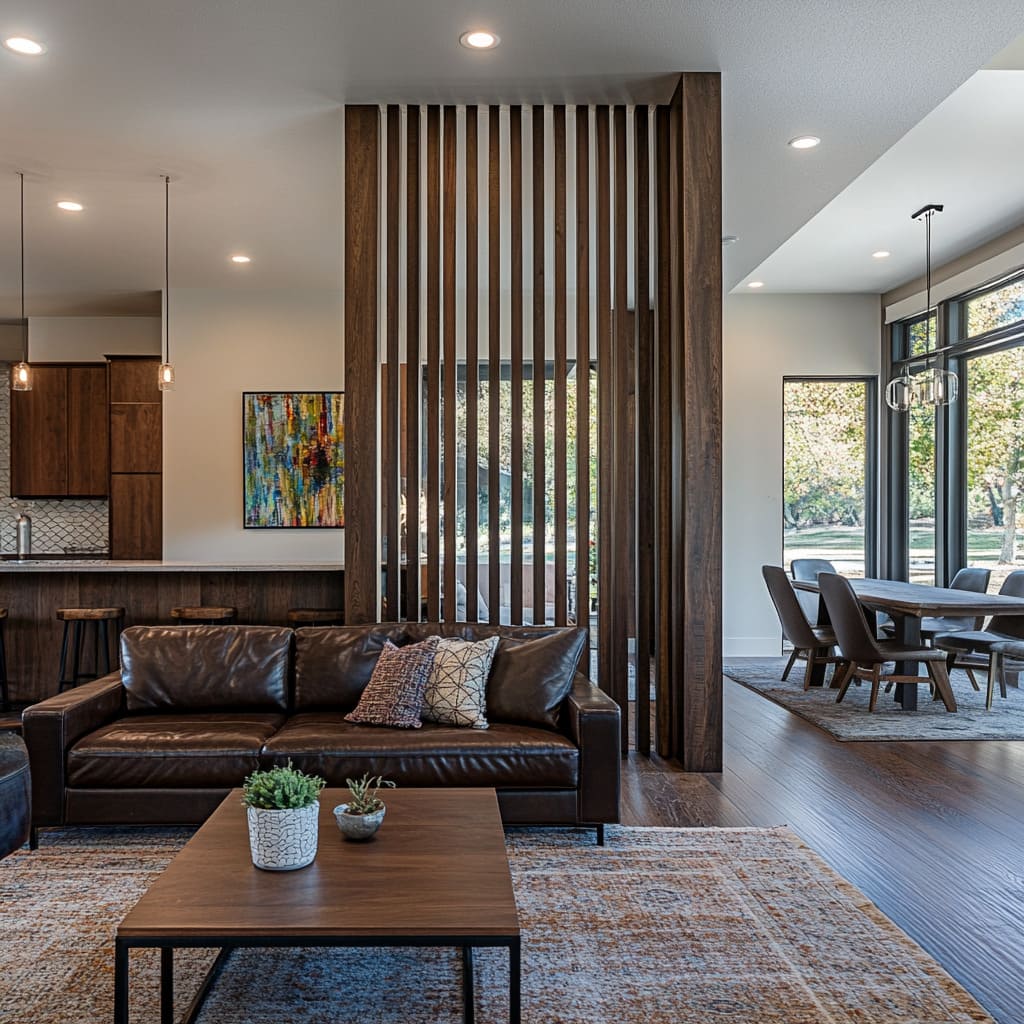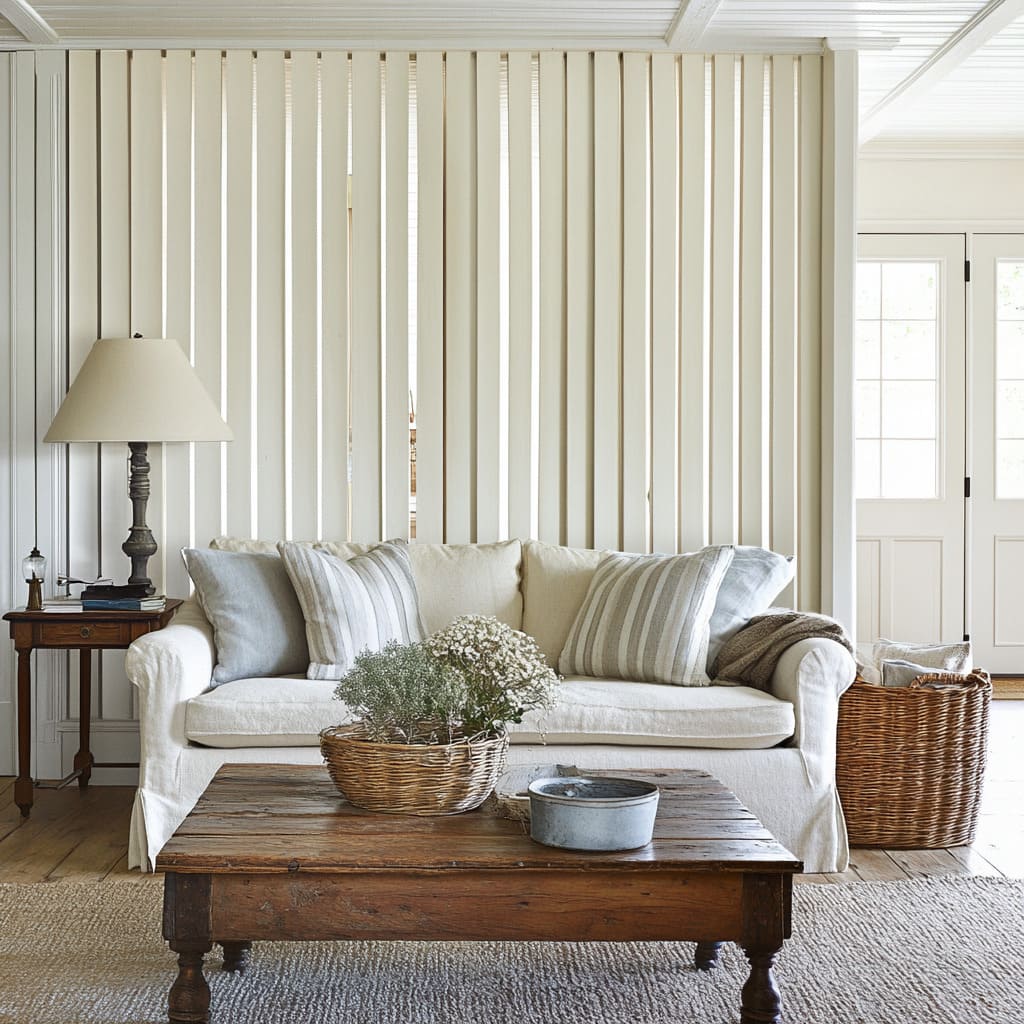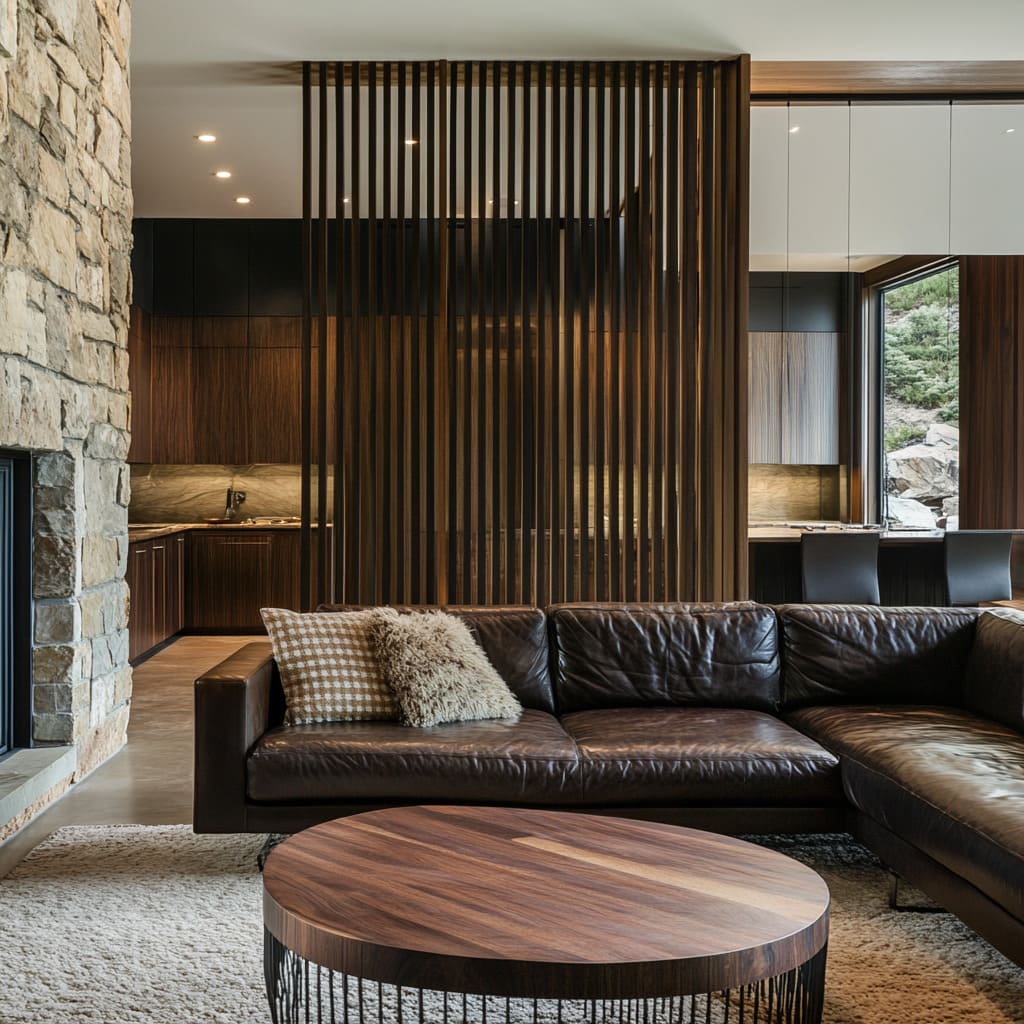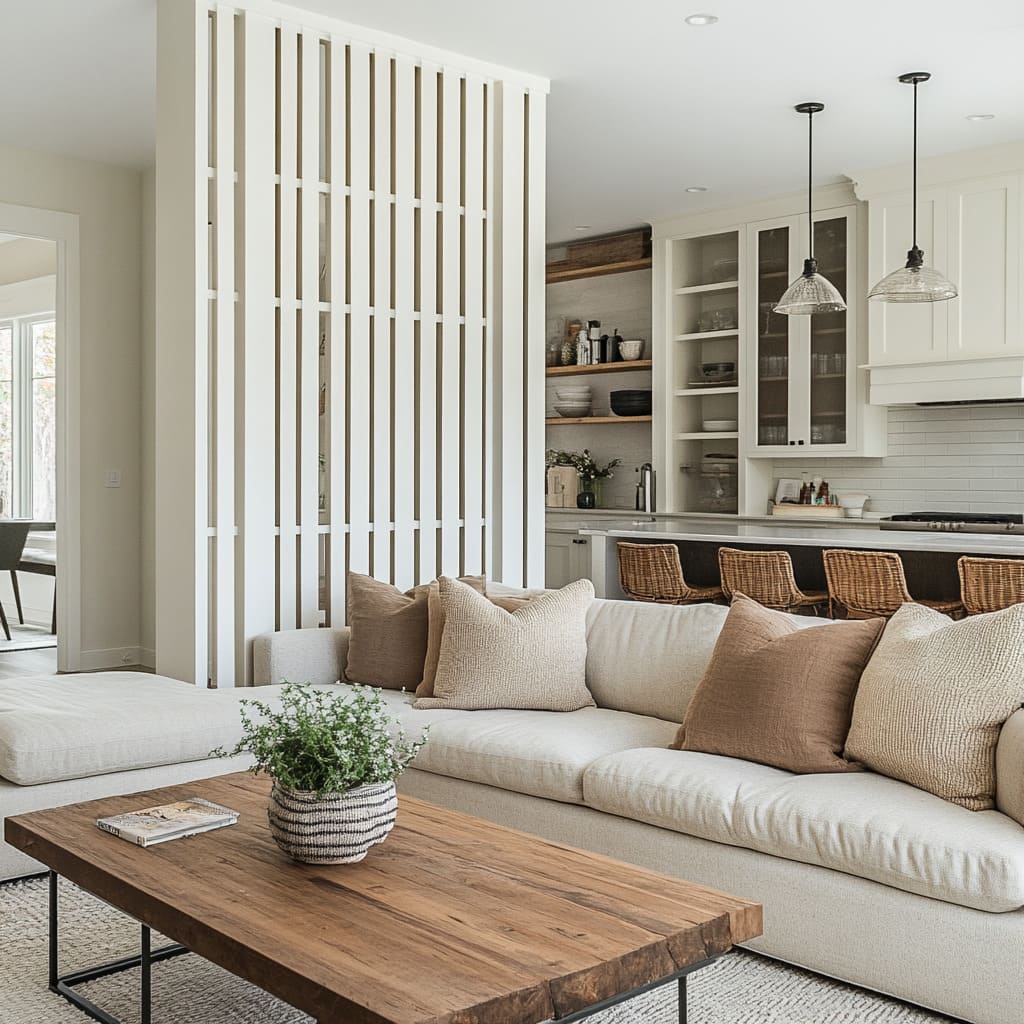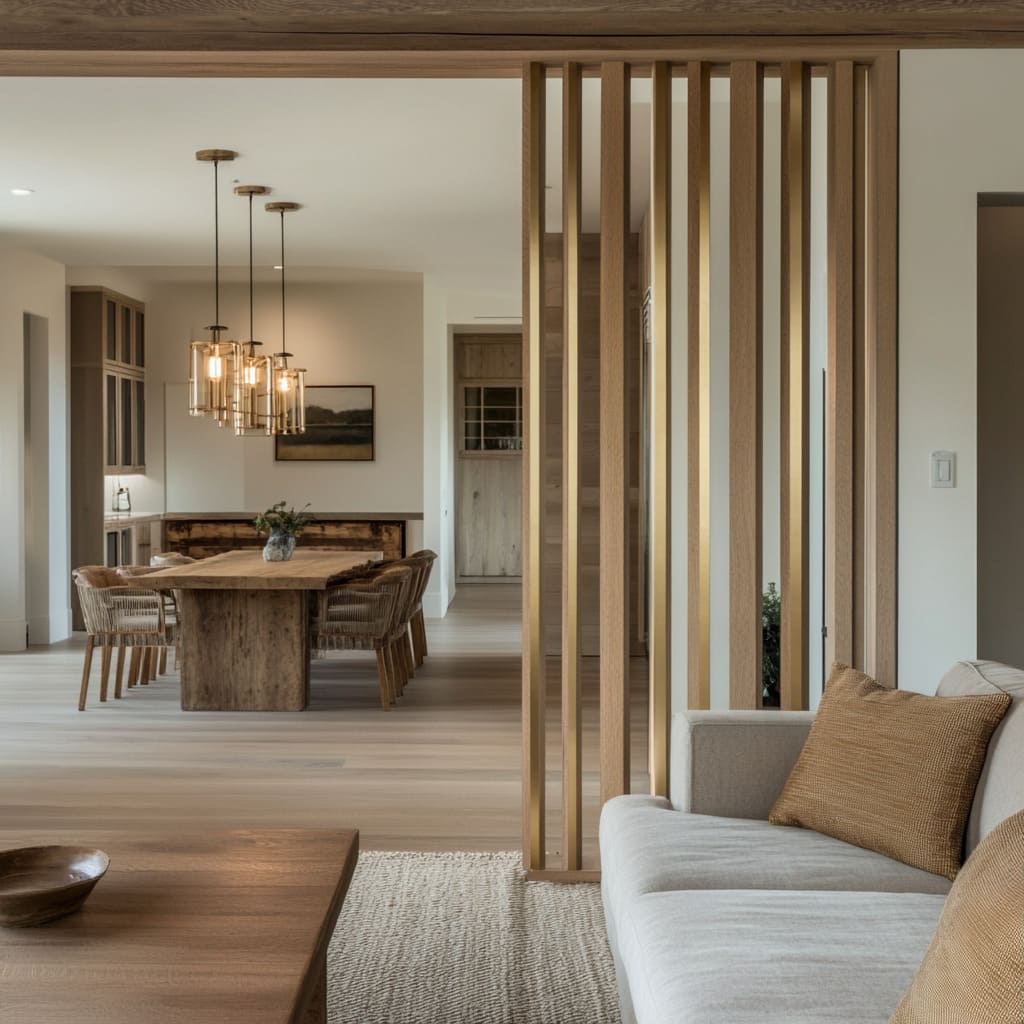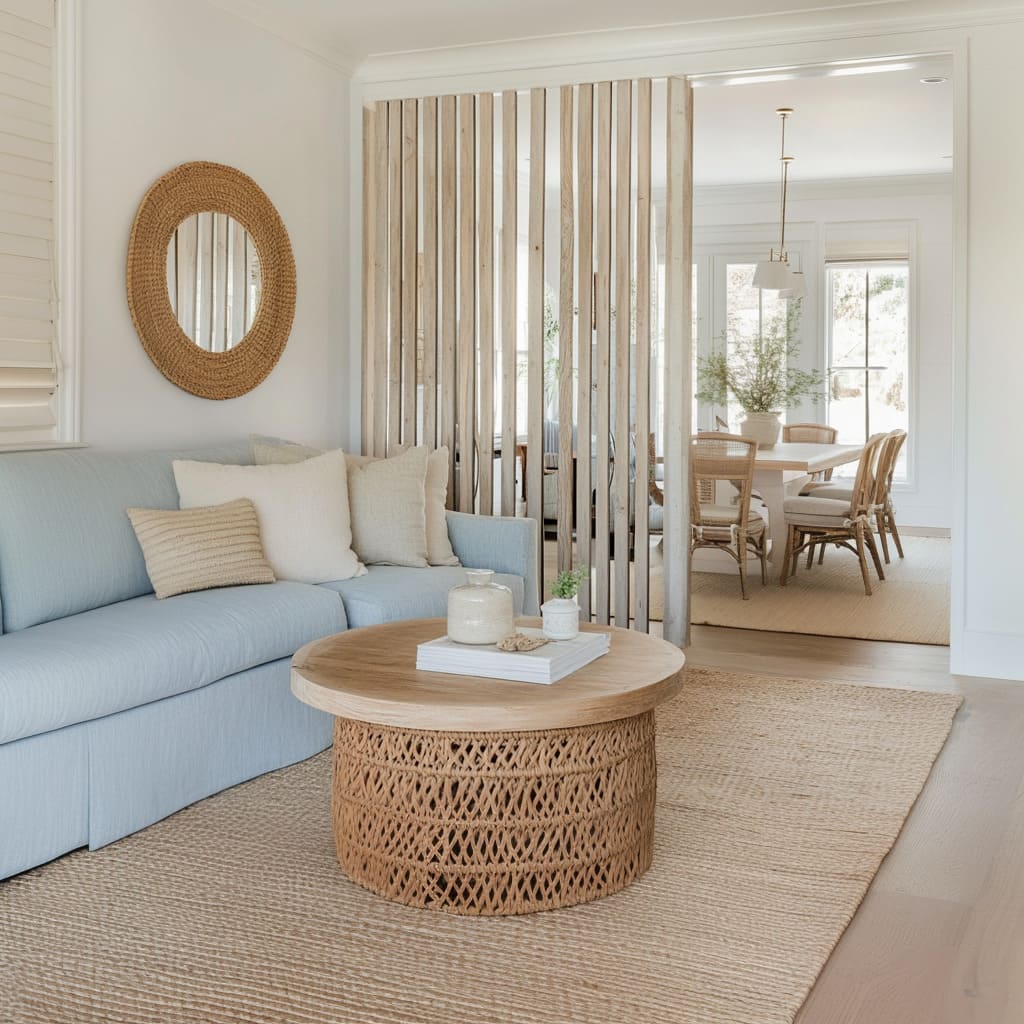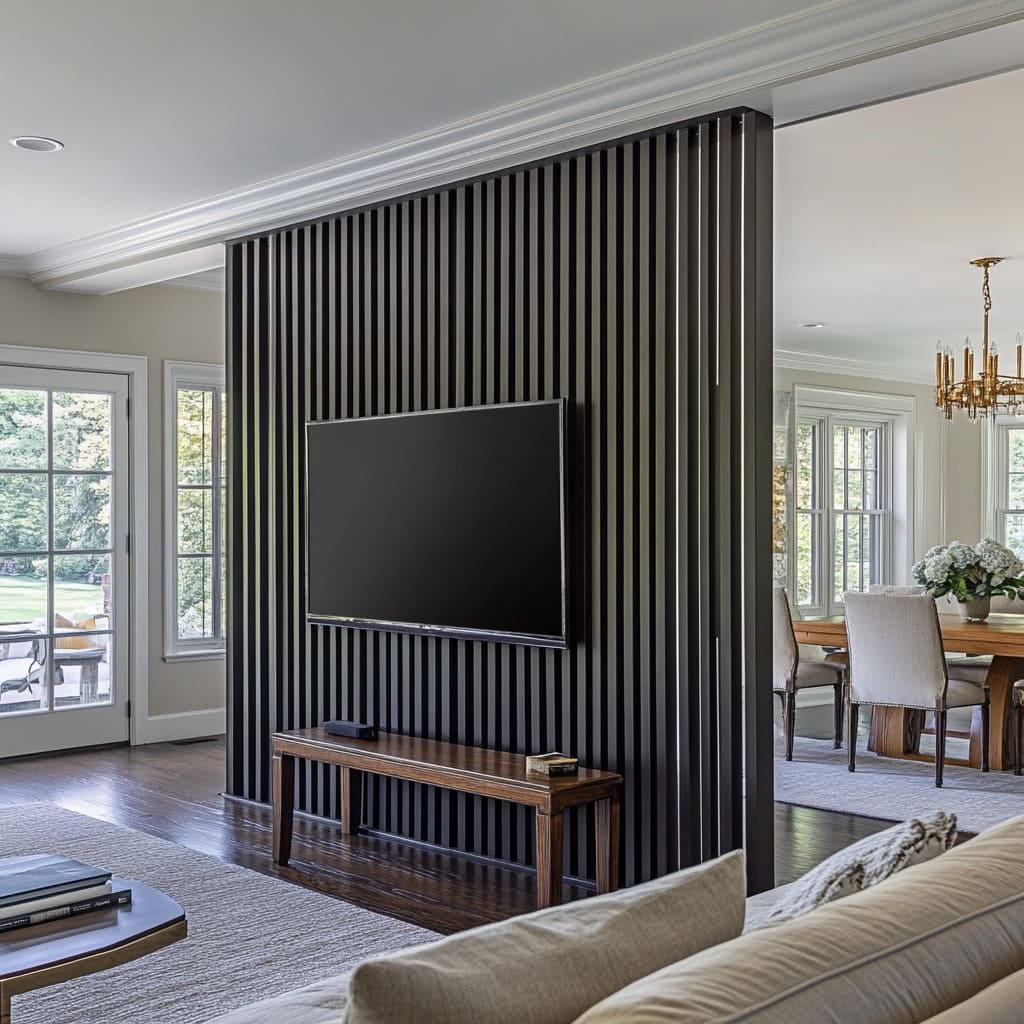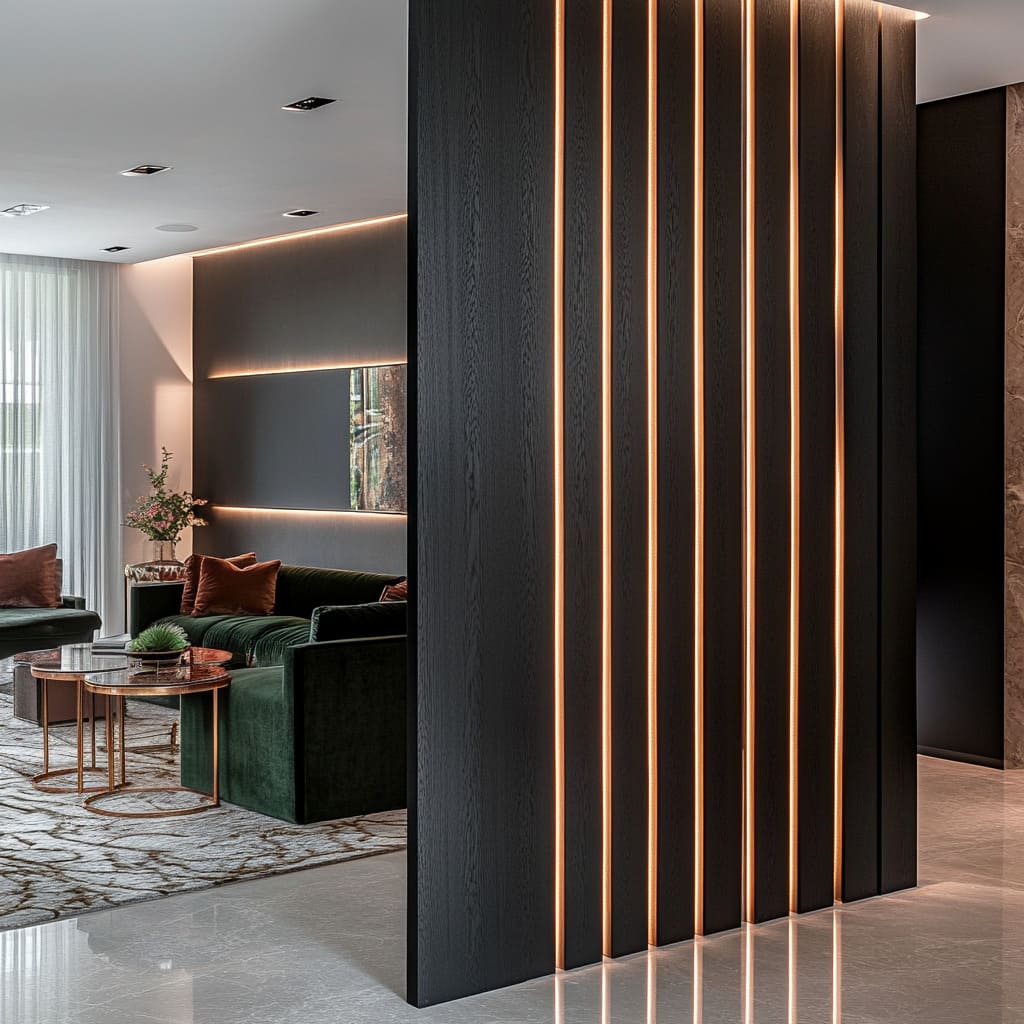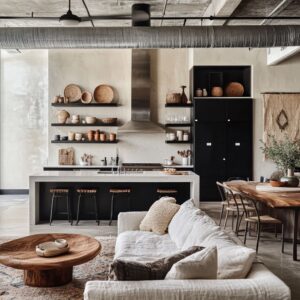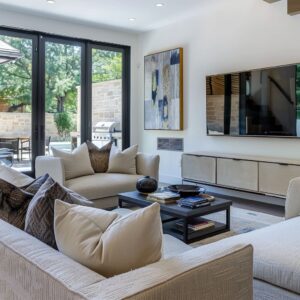Slat wall dividers offer a practical and visually striking way to add privacy to open layouts, without the need to construct solid walls. Their growing popularity in modern homes stems from the need to define spaces while keeping an airy and open feel.
In homes that embrace open-plan designs, where kitchens, dining rooms, and living areas seamlessly flow into one another, homeowners often seek subtle ways to create defined zones. Slat walls have become the go-to solution for those looking to segment areas while maintaining the flow of natural light and preserving sightlines.
These dividers are not just about functionality; they bring a design element that elevates the overall look of a space. As more homeowners embrace the openness of contemporary homes, slat dividers have emerged as a key feature, blending both practicality and style.
Whether used to define a cozy living area from a dining space or to screen a kitchen from the family room, slat wall ideas provide an aesthetic solution that feels far less intrusive than traditional walls or bulky partitions.
One of the most appealing aspects of slat walls is their versatility. They come in a variety of materials and finishes, allowing for endless design possibilities.
Whether you’re going for the natural warmth of a wood slat room divider or a sleek, modern look with darker tones, slat walls can complement a wide range of interior styles. From the minimalism of light oak slats in a Scandinavian-inspired home to the bold statement of dark walnut in a contemporary setting, the options are as varied as the spaces they adorn.
Not only do slat walls allow flexibility in materials, but they can also be configured in numerous ways. You can adjust the spacing between slats, use them in vertical or horizontal arrangements, or even incorporate metallic or glass accents.
These configurations can cater to specific needs—wider gaps between slats offer more transparency, while tighter spacing ensures greater privacy. Creative slat accent wall ideas can include integrated lighting or even planter boxes, adding a fresh, dynamic layer to your room’s design.
In modern home design, where clean lines and multifunctional spaces are key, slat wall dividers perfectly embody this trend. They act as an architectural feature that doesn’t overwhelm the room but enhances its functionality and aesthetic appeal.
Whether dividing spaces or adding a backdrop, these dividers bring both structure and style to any open layout.
Why Slat Walls Are the Perfect Choice for Open Layouts
The Challenge of Open Layouts
Open-plan spaces are loved for their sense of freedom and flow, offering expansive layouts that allow different areas—such as the living room, dining room, and kitchen—to blend seamlessly into one another. However, this very openness presents its own set of challenges.
The lack of physical boundaries makes it difficult to define spaces, which can lead to a feeling of disorganization or a lack of intimacy. Homeowners often find themselves needing to create zones within these wide areas, but traditional walls would ruin the open, airy atmosphere they’ve worked to achieve.
This is where slat wall dividers come in. They provide the ideal solution for sectioning off spaces without interrupting the room’s visual flow.
Slat walls allow light and air to pass through, keeping the space feeling bright and breathable, while still defining different zones within the layout. Their ability to create these divisions without cutting off sightlines or airflow makes them a preferred choice for modern homes.
The open gaps between the slats maintain a connection between areas, making slat walls a sleek, functional alternative to bulky partitions or solid walls.
Balancing Privacy and Openness
Slat walls strike the perfect balance between privacy and openness in an open-plan layout. While they don’t block off areas completely, they provide just enough division to offer a sense of separation and privacy.
Depending on the design, slat walls can create more or less privacy. For example, thin, closely spaced slats made of dark wood create a more intimate and private zone, ideal for spaces like reading corners or quiet dining areas.
On the other hand, wider, more spaced-out slats in a light wood finish will maintain a greater sense of openness while still defining the space.
Another key feature of slat walls is how they can be customized to suit both functional and aesthetic needs. For a modern home, a modern wood slat accent wall can be used to divide the kitchen from the living area while keeping both spaces visually connected.
Meanwhile, the choice of slat material and color can enhance the overall mood of the room—darker finishes can make a space feel more sophisticated and grounded, while lighter finishes offer an airy, laid-back feel. This versatility makes slat walls adaptable to a variety of styles and preferences.
Whether you want a slat wall room divider that provides more enclosure or one that maintains a strong sense of connection between areas, the design options are almost limitless. The ability to personalize the slat width, height, and material means that homeowners can achieve the exact level of openness or privacy they desire, creating a space that feels cohesive yet functional.
Aesthetic Value of Slat Wall Dividers
Visual Interest and Architectural Detail
While slat walls are undoubtedly practical for dividing open-plan spaces, their real charm lies in the way they transform the room visually. More than just a functional partition, slat walls introduce texture, depth, and interest to otherwise plain spaces.
By varying materials and finishes, slat walls can complement or even enhance the home’s existing design.
Take, for example, the natural warmth and sophistication that light oak or walnut slats bring into a room. These wood slat wall ideas are popular not only for their ability to divide spaces but for the natural texture they introduce.
The vertical lines of the slats draw the eye upward, creating a sense of height and spaciousness. In many examples, the organic tones of the wood balance the modern architecture of the home, grounding it with a natural element.
Walnut slats, with their rich, dark tones, lend a sense of timeless luxury, while lighter oak slats give the space a fresh and airy vibe. This attention to material choice adds layers of interest that go beyond what a plain wall could achieve.
The repeating rhythm of the slats, whether thin or wide, creates a visual cadence that adds depth to the room. Even in minimalist interiors, the presence of a slat wall provides just enough texture to prevent the space from feeling too stark or sterile.
Slat Walls as Statement Features
Beyond their subtle architectural detailing, slat walls have the potential to become standout features in a room. In modern interiors, slat walls often serve as statement pieces that command attention.
Consider a black slat divider paired with integrated LED lighting. The dark wood contrasts against the brightness of the room, creating a dramatic focal point.
The addition of soft lighting between the slats enhances the look even further, casting a warm glow that makes the feature wall feel bold yet inviting.
Another example is the use of mixed materials. A slat wood room divider incorporating metallic accents such as brass or rose gold can elevate the design, introducing a sleek, polished touch.
These metallic accents catch the light, adding a subtle shimmer that breaks up the matte texture of the wood. Some designs even combine slats with materials like glass or stone, resulting in a look that feels luxurious and refined.
One design featured slats with copper details, and the contrast between the natural wood and the glimmering copper offered a balance between rustic charm and modern sophistication. Whether subtle or bold, these slat dividers have a significant impact on the space’s aesthetic.
In open-plan homes where walls are few and far between, these dividers become a defining design element, making them both functional and visually impactful.
How Slat Walls Enhance Functional Space in Open Layouts
Defining Zones with Style
In open layouts, one of the biggest challenges is creating a sense of separation between different areas without compromising the overall flow of the space. Slat walls have become a go-to solution for defining zones while maintaining a cohesive and uninterrupted design.
Instead of putting up traditional walls, which can make spaces feel small and closed off, a slat wall creates a softer division.
Take, for instance, the common scenario of a living room that flows into a dining area or kitchen. A slatted wall divider can be placed between these spaces, subtly marking the transition from one zone to another while keeping the room visually connected.
In one example, walnut slats are used to frame a kitchen and living room, adding a rich texture to the design. The dark, warm tones of the wood introduce a sense of sophistication, while the open gaps between the slats ensure that light continues to travel freely between the rooms.
This clever design trick ensures that even though the spaces are distinct, they still feel part of a larger, unified whole. The beauty of using slat dividers for zoning lies in their ability to create boundaries without adding visual clutter.
Instead of stopping the eye with a solid wall, the vertical slats provide just enough separation to signal a change in space, all while maintaining an open, airy feel. This method is especially effective in modern homes that lean toward minimalism but still want some distinction between functional areas.
The Role of Slat Walls in Multi-Functional Spaces
In homes where rooms need to serve more than one function, slat walls offer a flexible and stylish way to organize the layout. Open-plan spaces often have to accommodate work, relaxation, dining, and entertainment all in one area, and this is where a well-placed slatted feature wall can make all the difference.
Imagine a home office that shares space with the living room. By adding a slat wall between the two areas, the homeowner creates a dedicated workspace that feels separate yet connected.
The slats act as a gentle barrier, offering a degree of privacy without the closed-off feel of a traditional wall. This type of layout is ideal for maintaining a functional flow in spaces where one area serves multiple purposes.
Beyond just dividing spaces, slat walls can also enhance functionality through their design. Some slat dividers come with built-in shelves or storage compartments, adding an extra layer of utility to the room.
For example, a divider with floating shelves can serve as both a visual partition and a practical storage solution. In this way, the slat wall not only helps to separate areas but also integrates additional storage or display options, making the most of the available space.
This combination of form and function is what makes slat walls such a valuable addition to multi-functional spaces. They allow homeowners to get creative with how they use their rooms, offering both flexibility and style without overwhelming the design.
Materials and Finishes to Suit Any Style
Choosing the Right Wood
When it comes to slat walls, the choice of wood can make all the difference in setting the tone for the room. Different wood types, combined with their respective finishes, can transform a space from modern minimalism to warm sophistication.
For those looking to achieve a natural, airy feel, light oak slats are an ideal choice. With their pale tones and subtle grain, light oak offers a Scandinavian-inspired aesthetic that adds brightness and an understated charm to any space.
This type of wood works especially well in open layouts where natural light plays a key role in the overall ambiance.
In contrast, darker woods like walnut are perfect for homeowners seeking a more luxurious and intimate environment. Walnut, with its rich tones and pronounced grain, brings a depth to the room that feels grounded and refined.
A vertical wood slat room divider crafted from walnut not only adds a layer of privacy but also serves as a design feature that instantly elevates the mood of the space. The warmth of the wood creates a welcoming atmosphere, making it an excellent choice for living areas or dining rooms where comfort and elegance are priorities.
Beyond the type of wood, finishes also play a crucial role in how the slat wall interacts with the rest of the room. For instance, a matte finish can give a more rustic, natural feel, while a polished or semi-gloss finish adds a modern edge, amplifying the wood’s natural beauty.
In rooms where light and openness are important, a lighter finish can help reflect light, contributing to a spacious and inviting feel. On the other hand, a darker, oiled finish can make the space feel cozy, ideal for creating intimate zones in larger open layouts.
Enhancing with Metal Accents
For those looking to add an extra layer of sophistication, metallic accents offer a seamless way to introduce contrast and elegance into a wood slat partition wall. Metals like brass, copper, and rose gold can be subtly integrated into slat wall designs to enhance the overall aesthetic.
One approach is to use brass mesh or thin metallic strips between the wooden slats, creating a polished and refined look that elevates the entire space. This type of detail adds both texture and contrast without overpowering the natural beauty of the wood.
A great example of this can be seen in designs that incorporate rose gold accents. The soft sheen of rose gold blends harmoniously with wood, particularly in lighter finishes, adding a modern and upscale touch.
It brings out the warmth in the wood while also introducing a gentle contrast that makes the slat wall stand out as a feature in its own right. Whether it’s used in small touches, like fittings or mesh panels, or as a more prominent element, metallic accents create a balanced look that is both stylish and functional.
Copper is another excellent option for those looking to make a bolder statement. Its warm, reddish tone complements darker woods like walnut, enhancing the cozy, intimate vibe of the room.
Combining walnut slats with copper accents can transform a space into a luxurious retreat, where the interplay of wood and metal creates a rich, layered look. Incorporating these materials into slat walls isn’t just about visual appeal; it’s about adding depth and character.
The subtle gleam of metal can highlight the natural grain of the wood, making the divider more than just a functional feature—it becomes a statement piece that defines the space while enhancing its overall aesthetic.
Creative Integrations in Slat Wall Design
Planter Boxes and Greenery
One of the most captivating ways to bring life into a room while maintaining a natural, organic feel is by integrating planter boxes into room divider wooden slats. This trend blends architecture with nature, allowing plants to cascade gently between the vertical lines of the wood slats, creating a refreshing and vibrant atmosphere.
Whether it’s a leafy vine draping down through the gaps or smaller succulents nestled in between, the combination of natural wood and greenery evokes a sense of calm and connection with the outdoors.
These planter integrations are not only beautiful but functional as well, offering an inventive way to merge indoor living with elements typically reserved for outdoor spaces. A wood slat accent wall with built-in planter boxes can be particularly effective in homes that emphasize biophilic design—a growing trend focused on incorporating nature into interior spaces to improve well-being and environmental harmony.
The interplay of wood and plants adds a layer of texture, softening the hard lines of modern interiors while creating a lively focal point. The natural tones of the wood combined with the rich greens of the plants also offer versatility, working beautifully in homes with neutral palettes or those aiming for a more earthy, organic aesthetic.
Depending on the type of plants and wood finish chosen, the space can feel more tropical, Mediterranean, or minimalist, making this integration a highly adaptable design solution.
Lighting and Illumination
Lighting plays a pivotal role in setting the mood of any space, and when it comes to slat walls, creative illumination can elevate the overall design. Integrated lighting within wood slat accent wall structures offers a subtle yet striking way to highlight the textures of the wood and add warmth to a room.
Recessed LED lights, placed behind or along the edges of the slats, provide a soft, indirect glow that casts gentle shadows, emphasizing the vertical lines and enhancing the depth of the room.
One of the most effective uses of lighting in slat walls is placing LEDs behind the slats themselves. This method creates a halo effect that brings the wall to life, adding a sense of drama and visual intrigue to otherwise simple wooden structures.
When combined with metallic details, like brass or copper accents, the lighting can emphasize these materials, giving the wall a polished, sophisticated touch. For instance, black wooden slats paired with warm LED lighting can transform a room into a modern retreat, with the interplay of light and dark creating a bold, high-end feel.
In homes that lean toward more minimalist designs, lighting within slat walls can also be a way to introduce subtle texture without overwhelming the space. It’s not about flashy fixtures but rather a refined way of enhancing the wood’s natural grain and the rhythm of the slats themselves.
Whether used to highlight certain architectural features or simply to add ambiance, well-placed lighting within slat walls strikes the perfect balance between function and style, making the room feel both inviting and thoughtfully curated.
Slat Walls Across Different Styles
Modern and Minimalist
In modern and minimalist interiors, decorative slat walls are the perfect embodiment of understated elegance. These designs focus on clean, simple lines that maintain a sense of openness while subtly defining different zones in an open-plan space.
For a modern look, thin, evenly spaced slats in light wood, like oak or ash, bring a fresh, airy quality to the room without overwhelming the overall design. In some of the images we’ve explored, light wood slats blend seamlessly into the neutral color palette, enhancing the minimalist aesthetic without adding visual clutter.
The repetition of the slats introduces rhythm into the space, but in a way that feels balanced and restrained.
Minimalist slat wall designs often focus on creating harmony between structure and light. By allowing natural light to filter through the gaps in the slats, these dividers preserve the airy feel of the space while offering a subtle layer of privacy.
The neutral tones of the wood—whether lightly whitewashed or kept in its natural form—anchor the room without distracting from the rest of the decor, reinforcing the calm, orderly vibe typical of modern spaces.
Rustic and Farmhouse
For those who lean toward a rustic or farmhouse aesthetic, slatted partition wall ideas provide an excellent way to introduce architectural interest without losing the cozy, earthy feel of the home. Slat walls in these environments often take on a more natural, weathered look, with finishes that emphasize the wood’s grain and texture.
Aged oak, reclaimed wood, or even lightly distressed finishes help bring warmth to the room, while slats themselves offer a lighter touch than solid walls, maintaining an open, welcoming feel.
Rustic homes are known for their connection to nature, and wood slats are a perfect way to extend that feeling. When paired with other natural elements—like stone fireplaces, woven jute rugs, or exposed wooden beams—slat walls provide a cohesive design element that ties the entire space together.
The organic texture of the slats enhances the cozy charm, while the structure provides a functional way to create distinct zones in large, open layouts without feeling closed in. In some of the examples we’ve seen, pairing slat walls with farmhouse-style furnishings creates a harmonious, layered look that feels inviting yet stylishly rustic.
Luxurious and Refined
In more upscale, refined spaces, slat walls take on a bolder, more dramatic role. Using darker woods like walnut or even black finishes, these walls act as striking focal points, exuding a sense of sophistication while still serving a practical purpose.
For luxurious interiors, slat walls are often crafted with meticulous attention to detail, incorporating high-end materials like brass, copper, or even rose gold accents. This combination of rich wood tones and gleaming metallics elevates the space, making the slat walls feel like bespoke pieces of art rather than simple room dividers.
One example of this refined approach is the use of slatted partition walls with integrated LED lighting. The contrast between the dark wood and the soft glow of recessed lighting creates an atmosphere that feels both modern and opulent.
In some homes, brass mesh or metallic details are woven between the slats, adding depth and a touch of elegance. Whether the walls are used to frame a lounge or to divide a dining area from the kitchen, their role in luxurious spaces is to balance function with high-end design, offering a sense of grandeur while maintaining the openness and flow essential to modern living.
Installation and Practical Considerations
Custom vs. Prefabricated Slat Walls
When it comes to choosing between custom-built slat walls and prefabricated options, there are key factors to consider based on both functionality and aesthetic preferences. Custom-built slat walls offer the advantage of being tailored to the specific dimensions and style of a room.
For example, a custom installation allows for precise alignment with existing architectural features, ensuring a seamless integration with windows, doors, and other structural elements. This level of personalization also means the homeowner can choose the exact material, finish, and spacing between slats, creating a one-of-a-kind piece that perfectly suits their space.
Whether opting for a light oak finish for a Scandinavian look or dark walnut for a more luxurious feel, custom slat walls offer endless possibilities for slat wall design ideas that match any style.
On the other hand, prefabricated slat walls provide a more affordable and convenient solution. Available in various materials and finishes, these pre-made options are often quicker to install and can still offer a sleek, modern look.
However, prefabricated slat walls may come with limitations in terms of customization. If choosing this route, it’s important to consider how the ready-made slats will fit within your space, and whether you may need to adjust the overall design to accommodate existing features like ceiling height or floor plan layout.
For both custom and prefabricated options, one of the most critical installation tips is spacing. The gap between slats significantly affects how much light passes through, as well as the level of privacy the divider provides.
Smaller gaps are ideal for areas where more privacy is needed, while wider gaps offer a more open, airy feel. Material choice also plays a key role—whether selecting wood, metal, or a combination of materials, make sure it aligns with the overall aesthetic and structural integrity of the room.
Maintenance and Durability
Maintaining the beauty and functionality of a slat wall requires regular upkeep, particularly if natural wood is used. Wooden slat walls, depending on the finish, may require specific care to preserve their appearance over time.
For instance, whitewashed or lightly treated wood may need periodic cleaning with gentle products to prevent discoloration or buildup. Dust tends to accumulate between the slats, so routine dusting or vacuuming is necessary to keep the slats looking fresh.
When it comes to durability, treated or varnished wood will generally require less maintenance than raw or minimally treated finishes. For darker woods like walnut or even black finishes, any surface scratches or nicks may become more visible, so it’s important to be mindful of the materials used.
In high-traffic areas or homes with pets and children, opting for more durable woods or materials can ensure the longevity of your vertical slat wall ideas without sacrificing style.
Additionally, slat walls with integrated elements like metal accents or LED lighting should be inspected regularly to ensure everything is functioning as intended. The combination of wood and metal, such as brass or copper details, can add a refined touch, but care should be taken to avoid tarnishing.
Regular cleaning of both the metal and wood surfaces will keep these elements looking polished, ensuring that your wooden room divider slats remain both practical and visually appealing for years to come.
Conclusion: Elevate Your Open Layout with Slat Wall Dividers
Slat wall dividers bring a unique combination of style, function, and flexibility to any open layout, making them an ideal solution for modern homes. Whether you’re looking to subtly define different zones within a space or introduce an eye-catching architectural feature, slat walls offer the perfect balance between privacy and openness.
The use of natural materials like wood brings warmth and texture into a room, while still allowing light and air to pass through, maintaining the spacious feel that open layouts are known for.
One of the greatest strengths of slat walls is their versatility. From a vertical wood slat partition wall that adds a contemporary touch, to slat designs integrated with lighting or greenery for a more dynamic effect, the possibilities are endless.
The ability to customize materials, finishes, and spacing between slats ensures that there is a solution for every style, whether your home leans towards sleek minimalism, rustic charm, or luxurious refinement. Slat walls truly blend the practical with the artistic, offering homeowners the opportunity to tailor their interiors to fit both their aesthetic and functional needs.
For those considering their next interior design project, a vertical wood slat wall divider could be just the element needed to transform an open space. The beauty of these dividers is in their adaptability, offering opportunities for creativity in both design and function.
Whether you are aiming to create a private reading nook, subtly separate a kitchen from the living area, or add a statement feature with metallic accents or greenery, slat walls provide an elegant solution.
Now is the time to explore the wide variety of slat wall options available and think about how this design feature could complement your home. From selecting the right materials to choosing the perfect finish, slat walls can be customized to reflect your personal style and meet the specific needs of your space.
As you consider your next steps, imagine how a thoughtfully designed slat wall can not only enhance your home’s visual appeal but also provide the practical functionality that open layouts often require.

